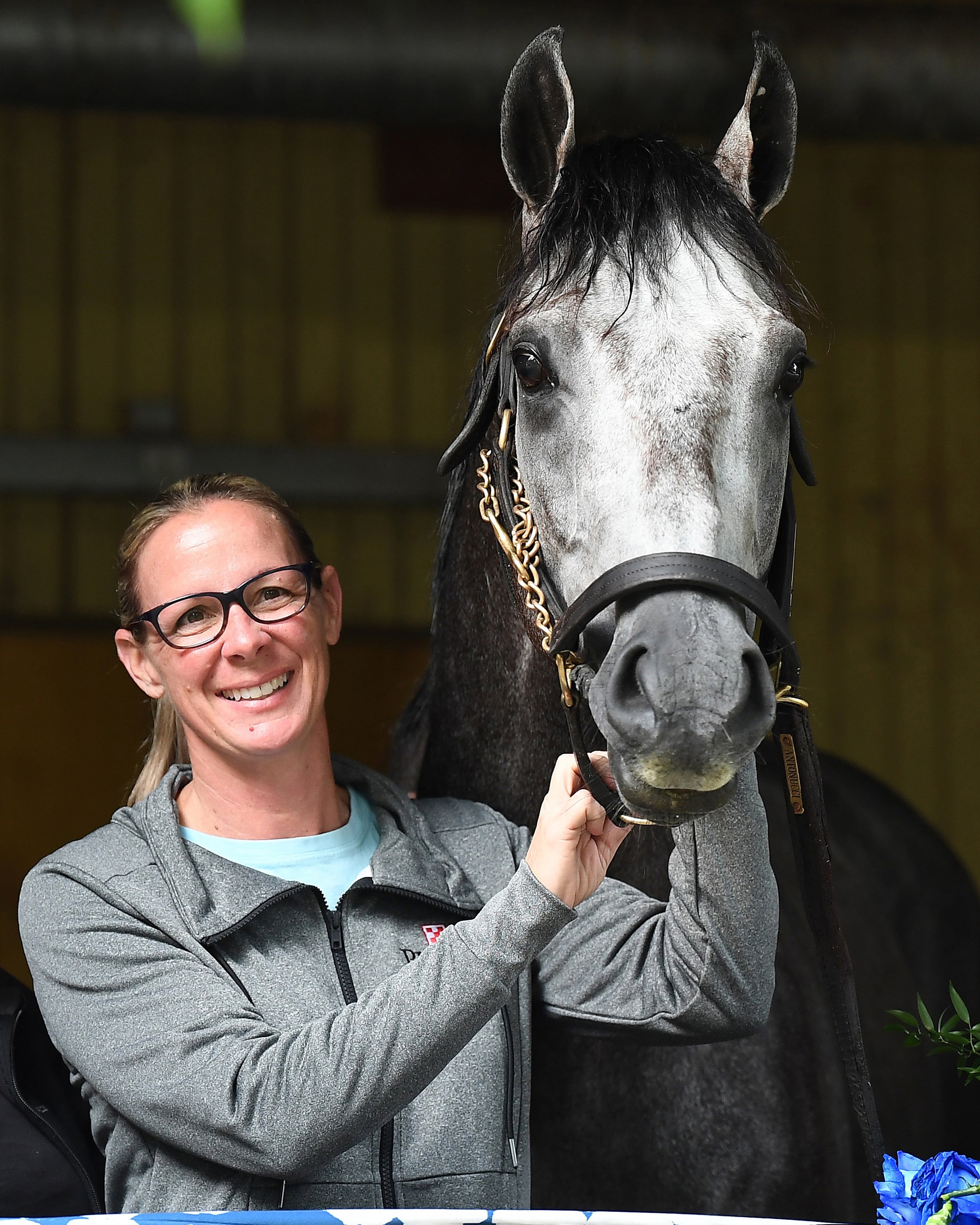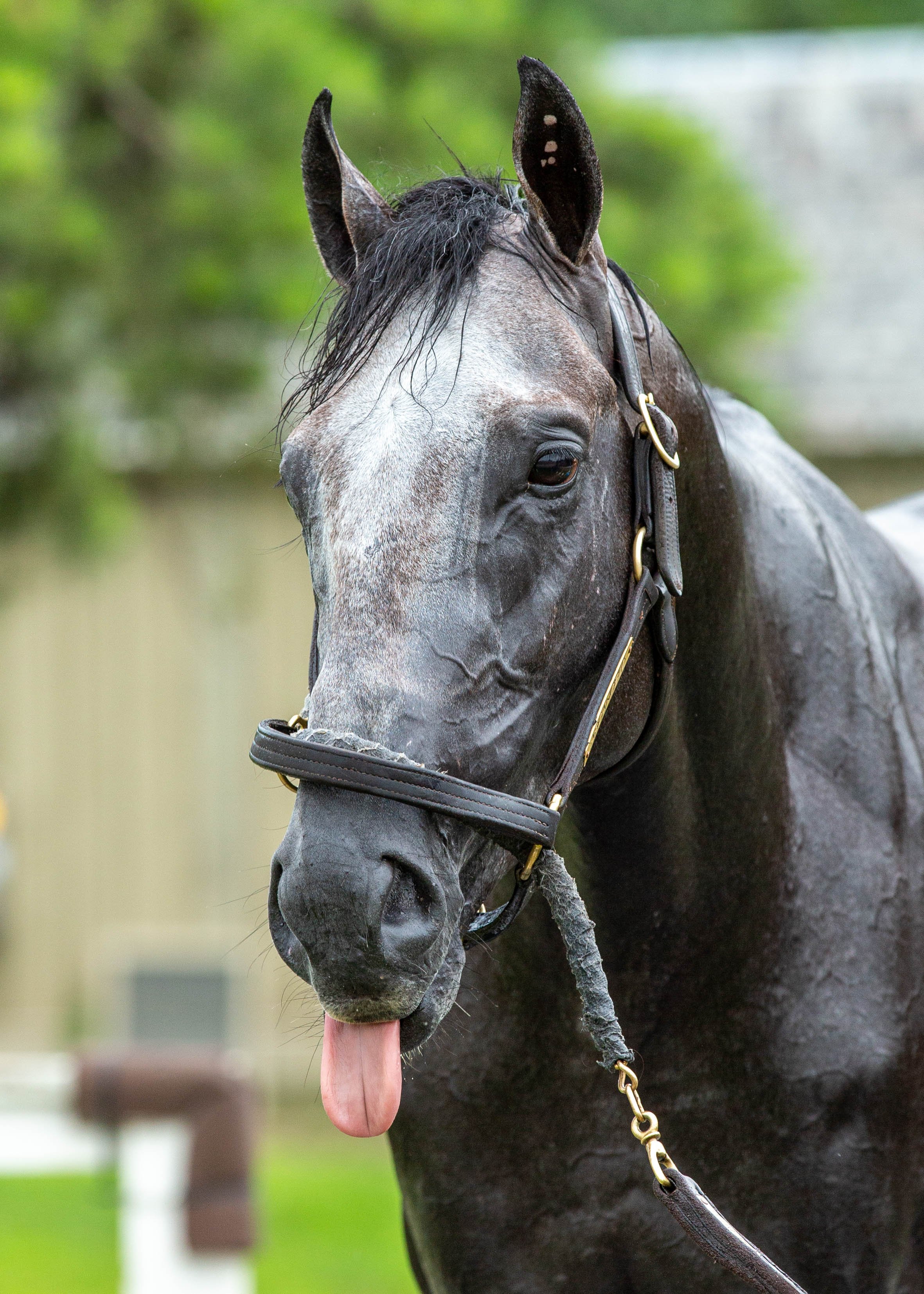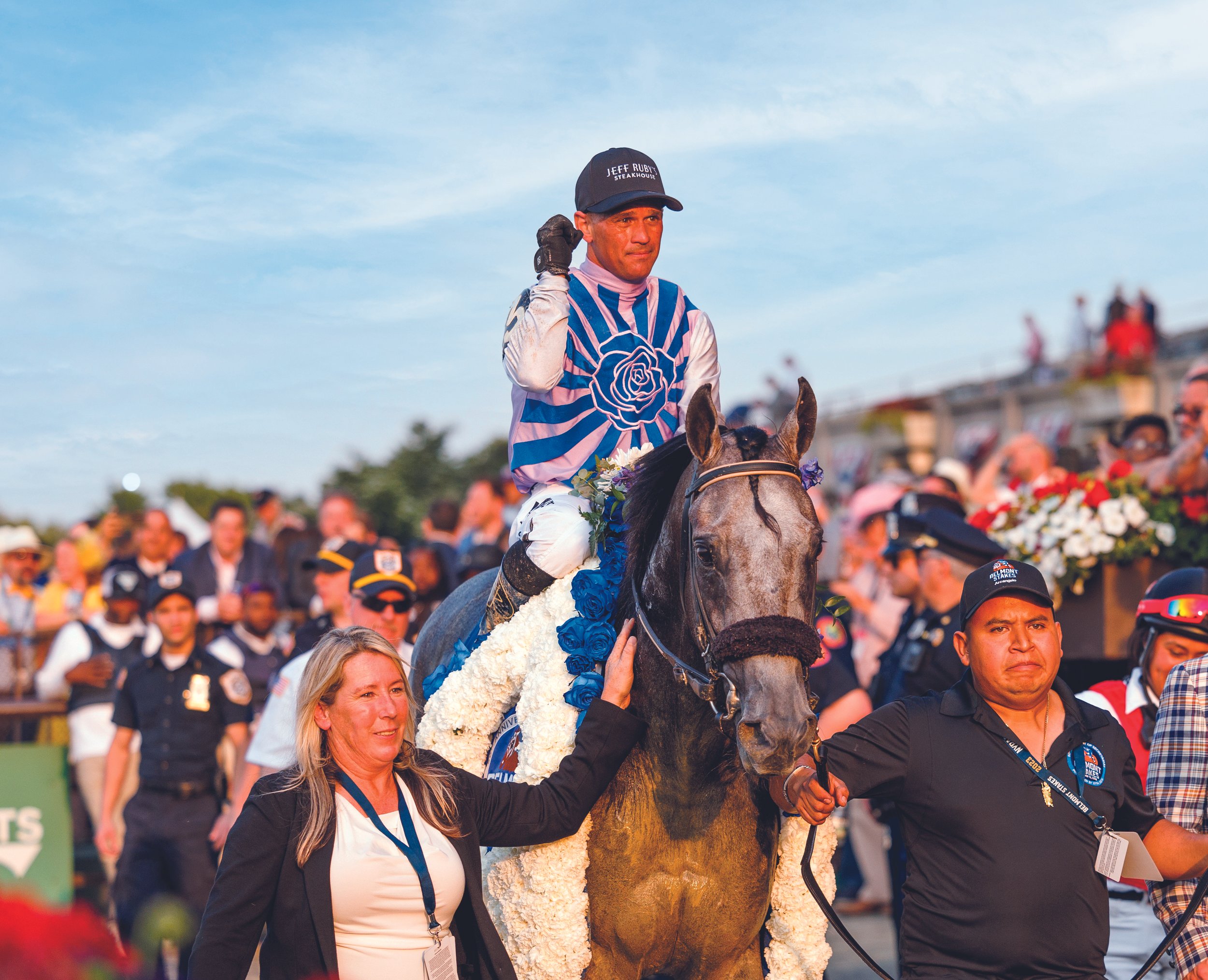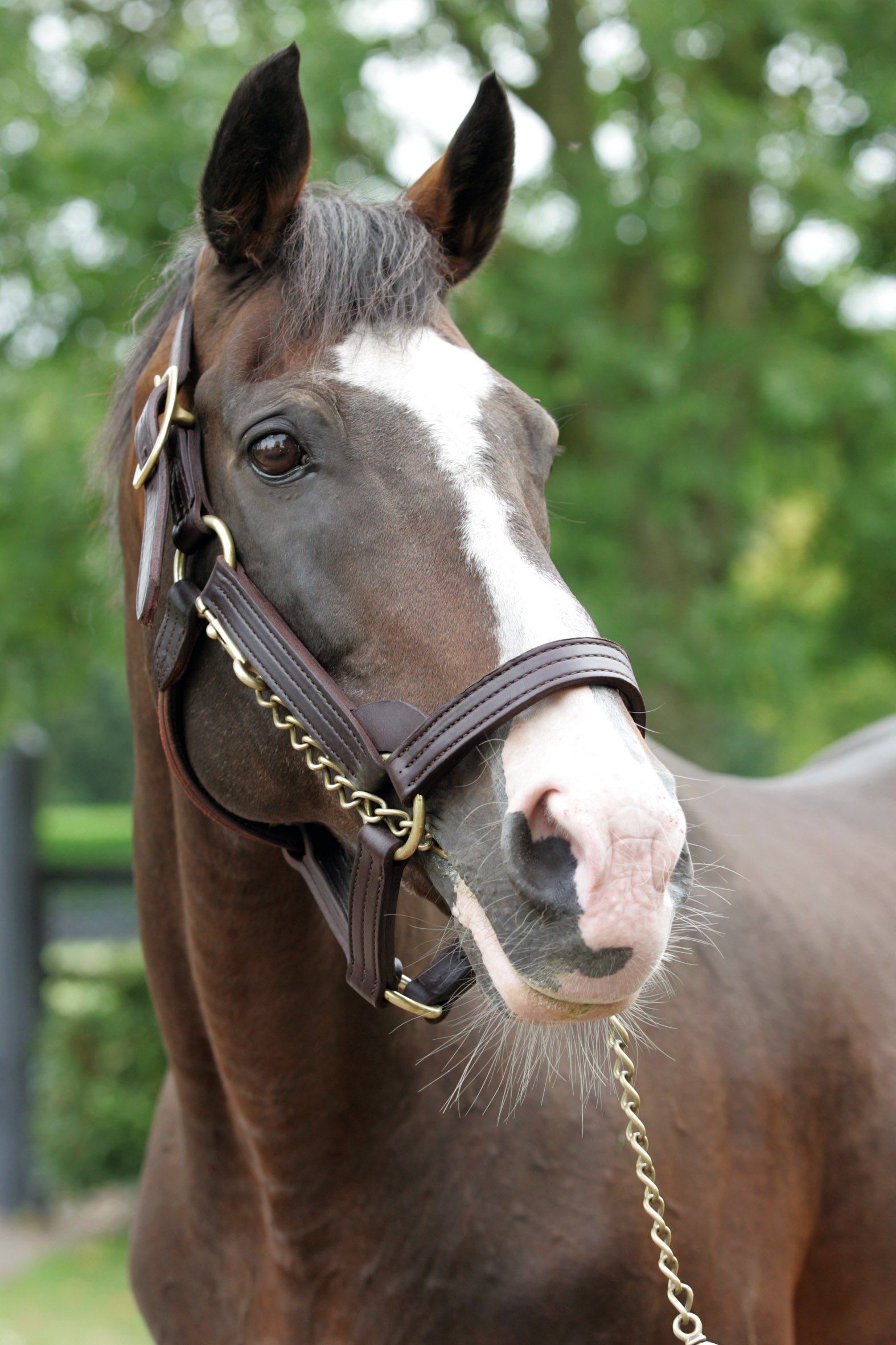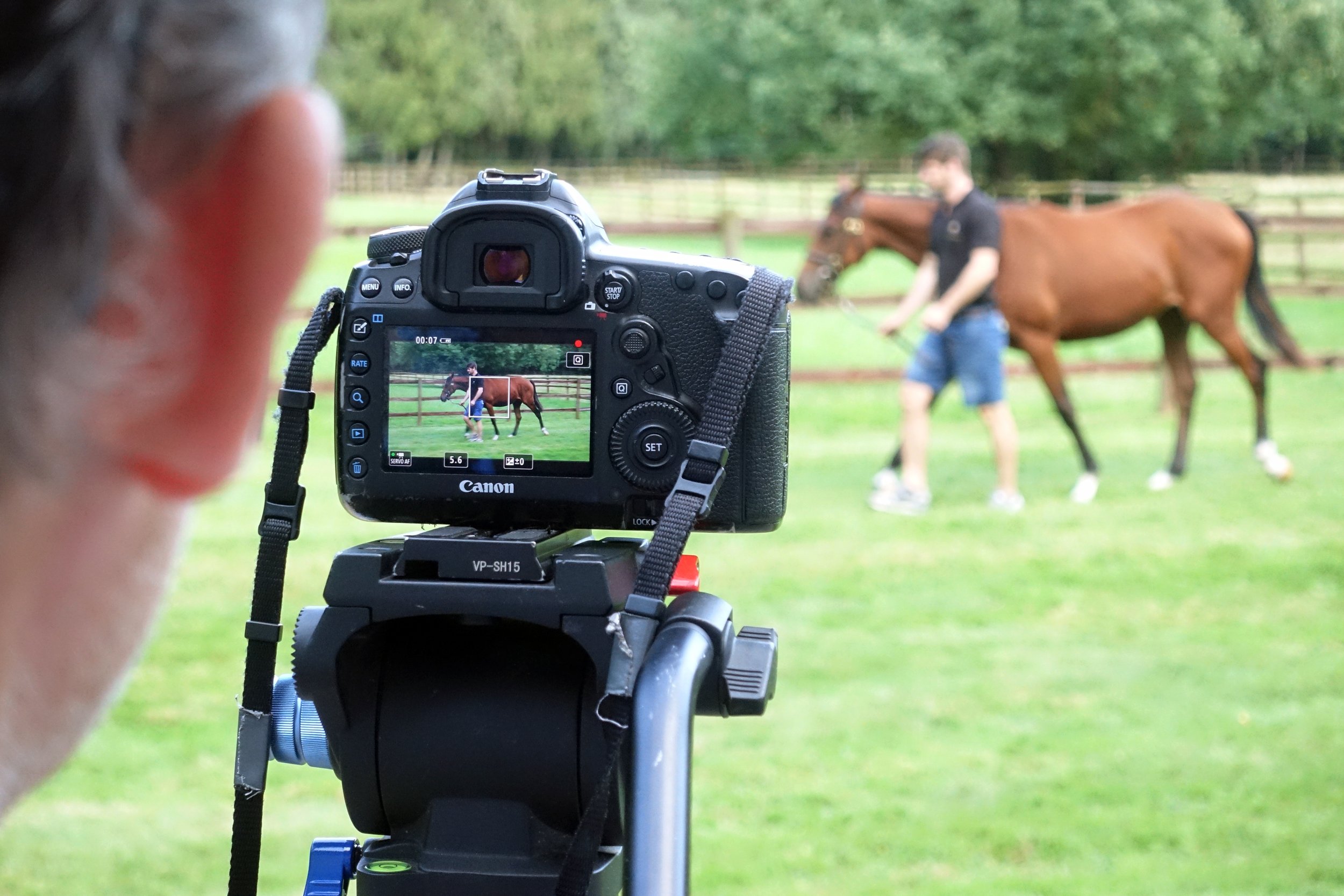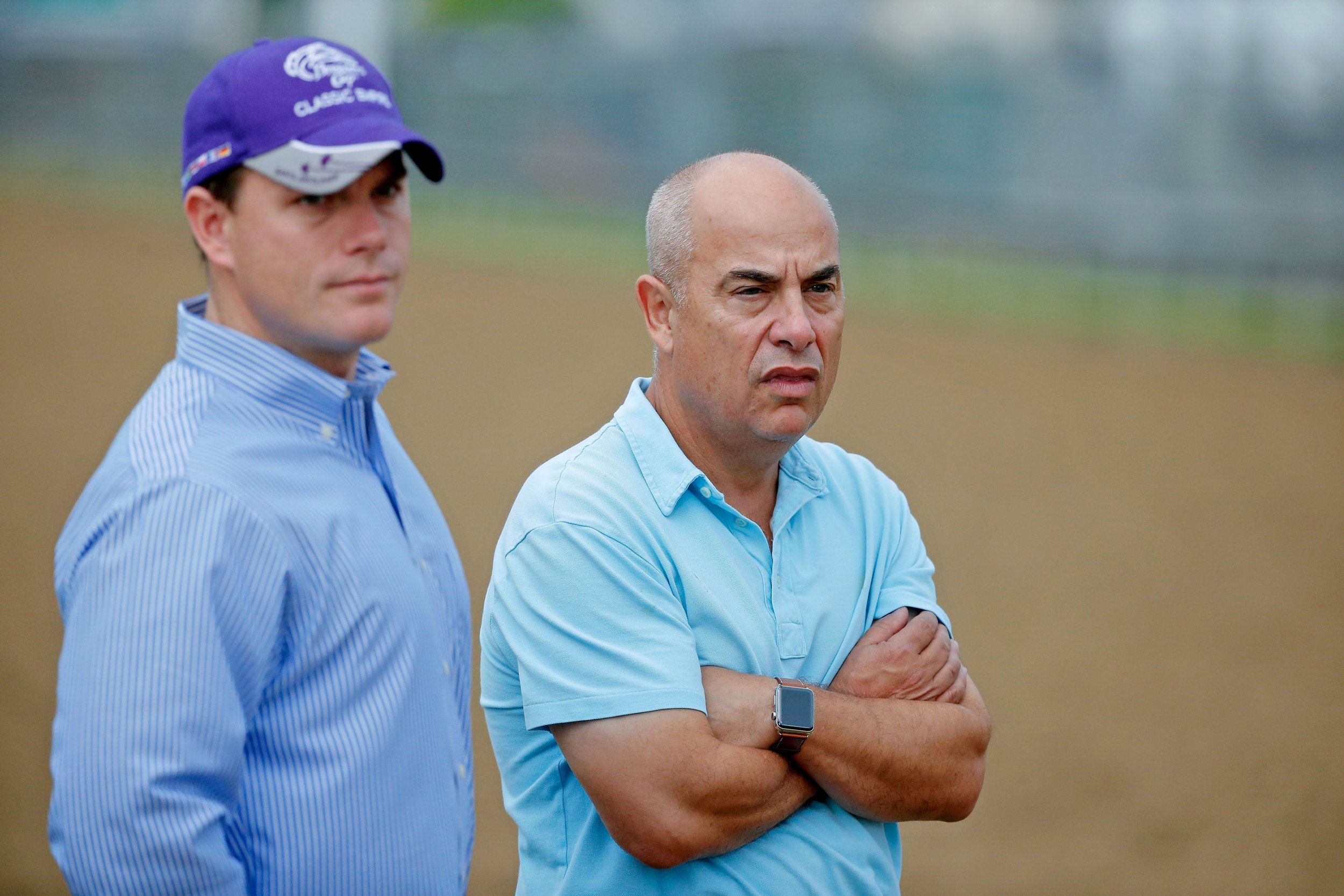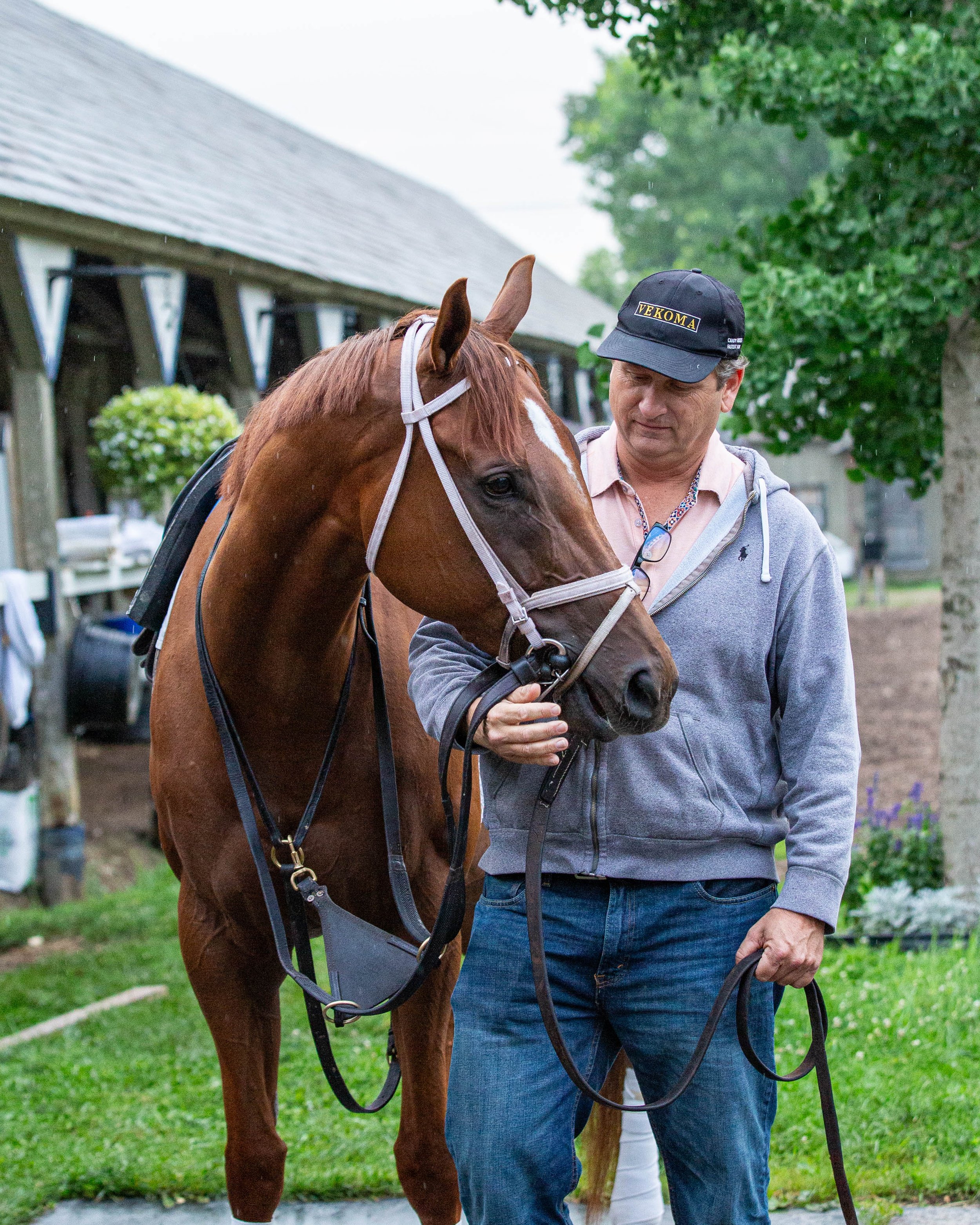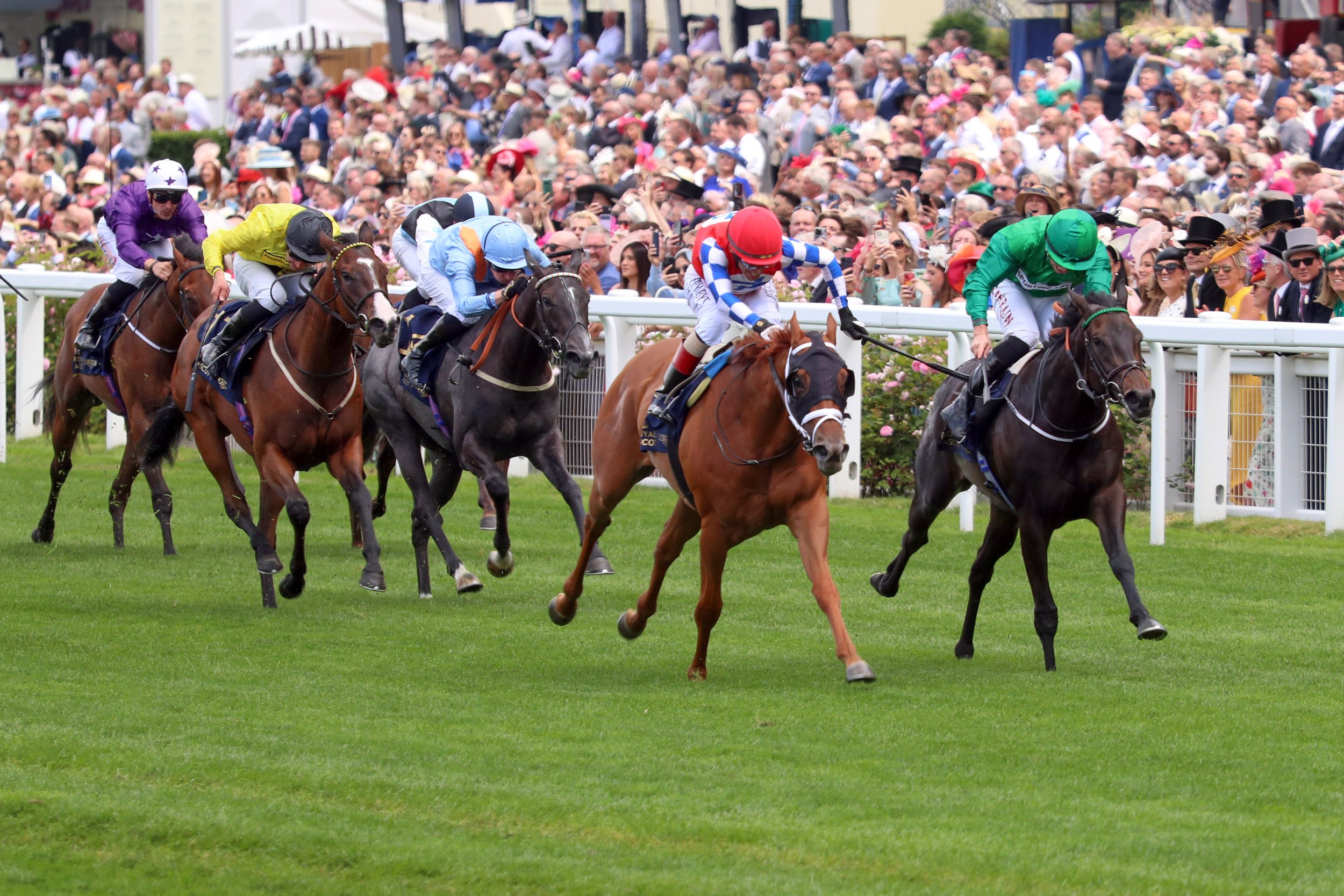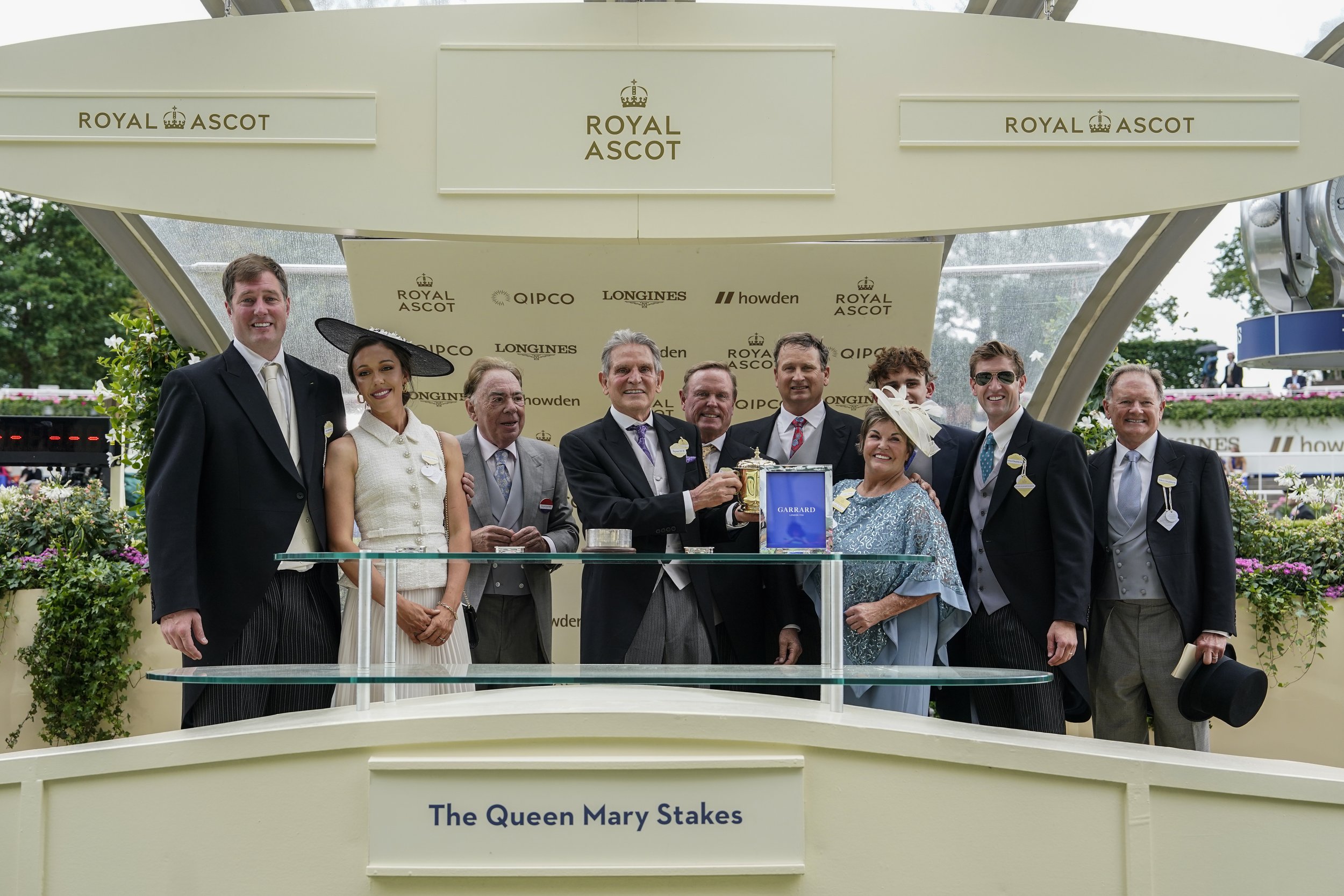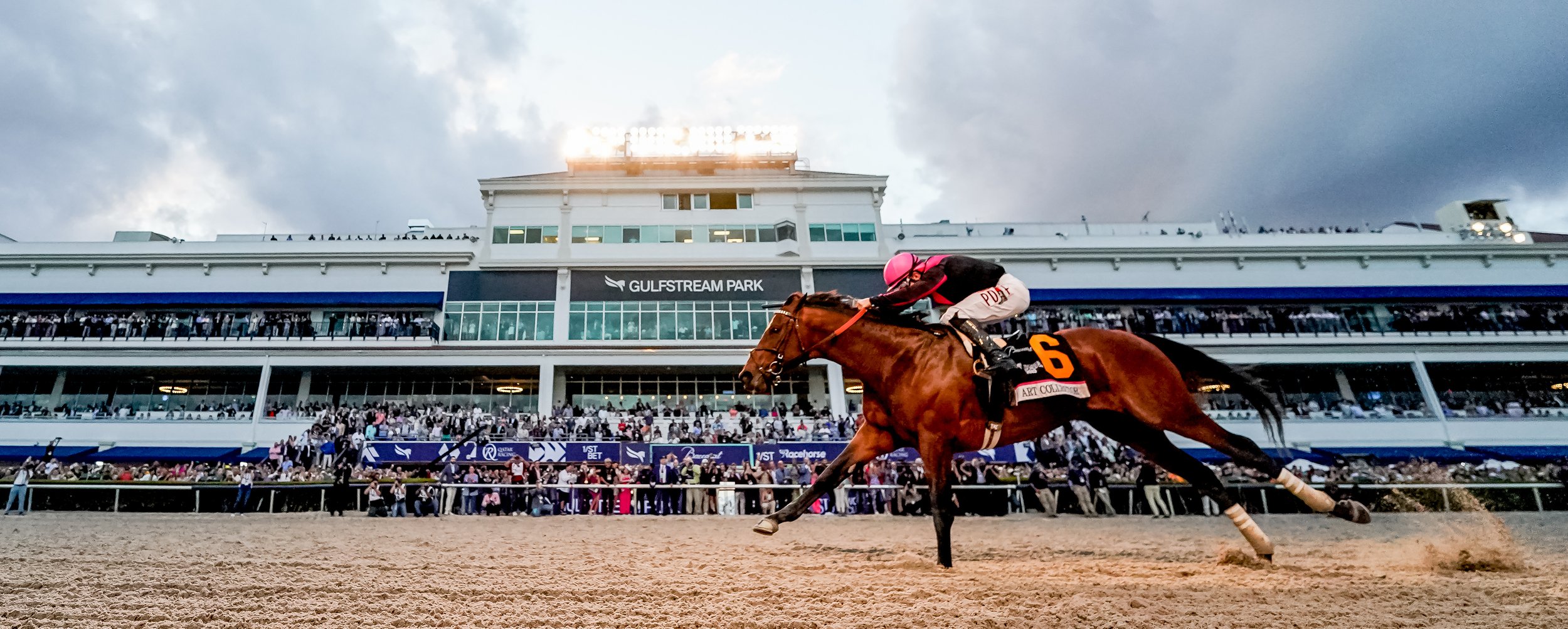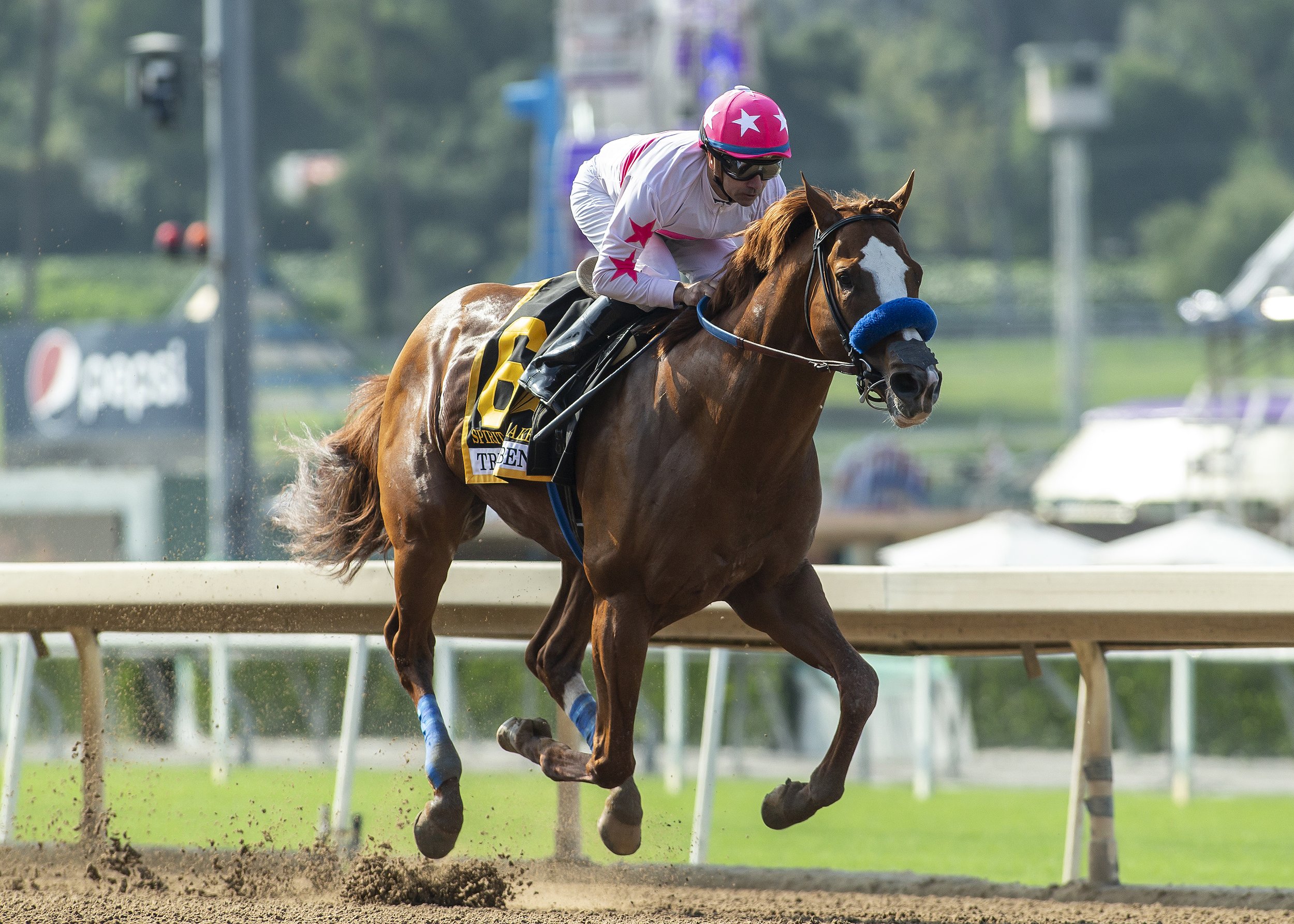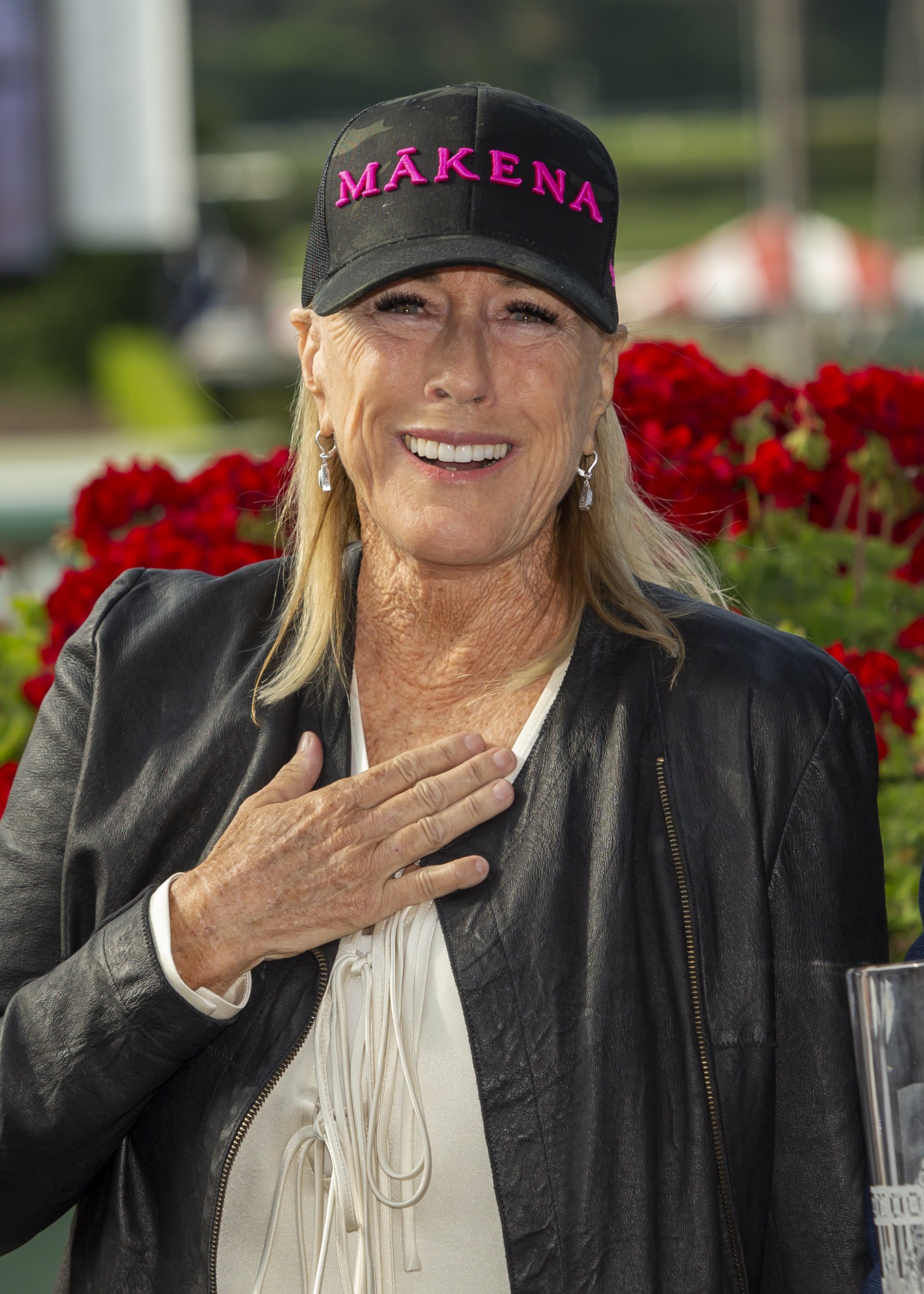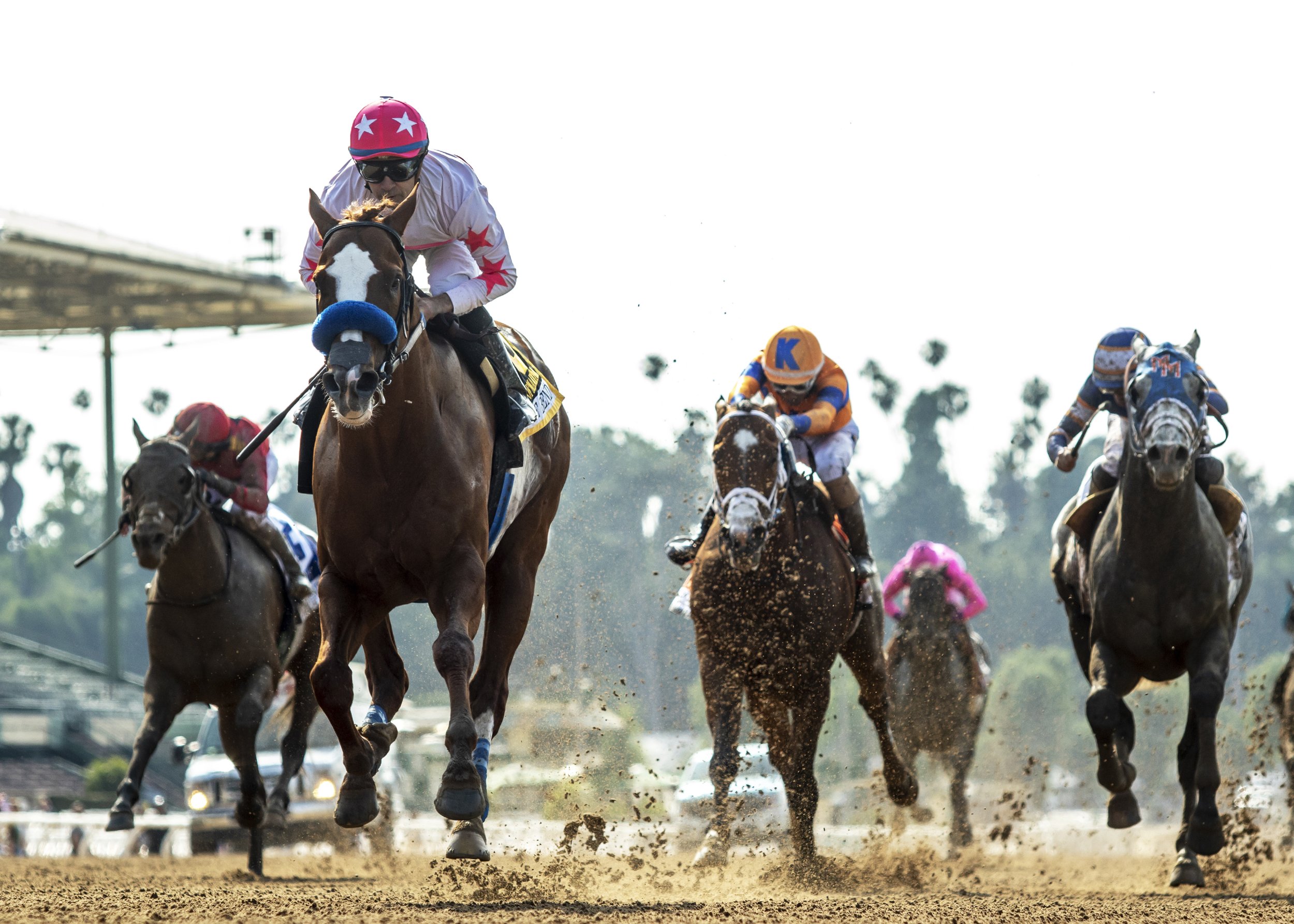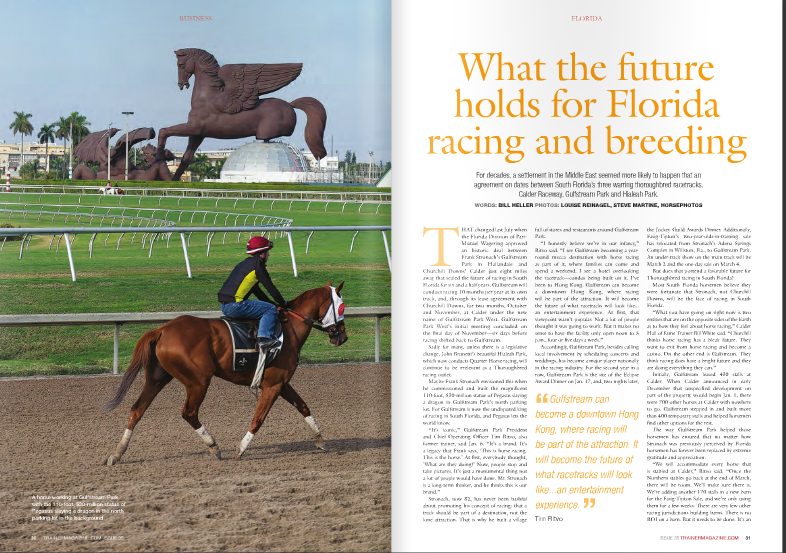Rich Mendez (Morplay Racing), Sheila Rosenbloom (Lady Sheila Stables) and Joey Platts – Guns Loaded
Article by Bill Heller
Only Thoroughbreds could bring together Rich Mendez, a music executive from Puerto Rico who believes he was conceived at Saratoga Race Course; Sheila Rosenblum, a ballet prodigy from Switzerland; and Joey Platts, a Wyoming cowboy and oil and gas industry executive. Guns Loaded did that when he captured the $145,000 Mucho Macho Man Stakes by a neck at Gulfstream Park January 4th.
“We’ve been very blessed,” Mendez, who founded Morplay Racing with his son Josh and partners Randy Hartley and Dean DeRenzo, said. “It’s been an amazing ride so far, and it taught me a lot because you never know when that next one comes.”
Mendez’s uncle, Victor Sanchez, was a jockey. “My uncle has been here at Gulfstream Park for 52 years,” Mendez said. “My mom used to walk horses at Saratoga with my dad. The story is I was conceived somewhere at Saratoga Race Course. I’m sure it was in a barn somewhere.”
It didn’t take long for Mendez to fall in love with horses: “I’ve always loved horses. The smell of being around the barn. It intrigued me. I just always loved watching the big races on TV. You always saw the white-haired trainer, Bob Baffert. He was a rock star.”
Mendez would work with rock stars in his career as a music executive at Rich Music, an independent record label he founded with his son Josh in 2007.
After purchasing his first property in Ocala, he met Harley. Then DeRenzo. Harley and DeRenzo let Mendez into their pinhooking operation. They, in turn, joined Morplay Racing.
At the September 2022 Keeneland Sales, Harley and DeRenzo landed an Iowa-bred colt named No More Time for $40,000. Racing as a two-year-old for trainer Jose D’Angelo, No More Time finished second in his maiden debut then won a maiden by 6 ¾ lengths.
No More Time made his three-year-old debut in the Macho Mucho Man Stakes and finished fifth. He rebounded to win the Gr. 3 Sam F. Davis Stakes by a length and a quarter, Morplay’s first graded stakes victory, and then finished second by a neck to Domestic Product in the Gr. 3 Tampa Bay Derby.
D’Angelo trains Guns Loaded, an $800,000 purchase at Keeneland. He too, finished second in his maiden debut and also won his maiden in second start. Stepping up to stakes company, he won the Macho Mucho Man.
Mendez said, “I love the fact that he is winning. My trainer and I, we’ve got a unique relationship. My trainer has become a really good friend. We talk probably three or four times a day.”
D’Angelo said, “I’m very happy to train for them. They have a lot of confidence in me. At the end of the day, you need good horses to be a good trainer.”
Sheila Rosenblum’s Lady Sheila Stable employs three talented trainers, D’Angelo, Linda Rice and Brad Cox. Two of them have her horses on the early Derby trail, Guns Loaded, trained by D’Angelo, and the undefeated, four-for-four New York-bred Sacrosanct, who is trained by Cox. “It’s your reason to wake up early every single day,” Rosenblum said. “You have a dream: be there in May. It’s very rare to have two possibilities on the same path for the Derby. It would be so amazing to me.”
She’s on an amazing run. Besides Sacrosanct, she and partners own the undefeated four-for-four New York-bred With the Angels, who is trained by Rice.
Rosenblum had a whiff of the Derby trail nine years ago when Matt King Coal finished fourth by 2 ½ lengths in the 2016 Wood Memorial. He didn’t make the Kentucky Derby, but he earned $662,650 in his career from just 13 starts.
Lady Sheila Stables top earner was La Verdad, the 2015 Eclipse Champion Female Sprinter who won 15 of 21 starts and earned $1,458,100. La Verdad died on May 10th, 2020, from complications with colic. Just six days earlier she had foaled a healthy colt by Into Mischief.
Dancing, not horse ownership, seemed her destiny. Born in Basel, Switzerland, she spent years at the Royal Ballet School in London, then the School of American Ballet, the associate school of the New York City Ballet in New York City: “I went there as a ballet dancer when I was 14 and I stayed.”
She would turn to modeling, working with the well-known agencies Wilhelmina and Ford, and then to horses: “My family didn’t like animals but I turned it into a way of life.”
She founded the all-female Lady Sheila Stable more than 10 years ago: “That was a dream come true from my ex-husband. He wanted to buy a dressage horse for me. I had this wonderful idea to get a couple of Thoroughbred yearlings. And he did. And that’s how it started. It’s the most humbling sport and profession. It’s been lovely. I’ve met a group of wonderful people.”
She is a board member of the March of Dimes, an advocate for children’s rights and is deeply committed to after-care for horses: “I’m very pro aftercare, especially New Vocations. We are all involved with them.”
Now, she is officially on the Derby trail with two horses: “The Derby is my son Erik’s birthday. All I can do is pray.”
She is realistic: “I don’t have the numbers others do. I have a handful. I’ve now spread my wings to breeding. It’s something I’m sticking to with a passion.”
Joey Platts’ passions are horses and rodeos. Born in the small town of Lyman, Wyoming, Platts won a silver belt buckle in team roping. His wife Wendy was Miss Rodeo Wyoming in 1981. They keep rodeo horses on their 30-acre farm in southeastern Wyoming near the Utah border.
Platts bought his first Thoroughbred from Becky Thomas of Sequel Stallions in the early ’80s, and they are still working together four decades later.
Looking for a tax write-off for his heavy construction business, the Platts claimed Lusty Latin for $62,500 after he finished second by a nose at Hollywood Park on November 29th, 2001. The following year, after finishing third in both the Gr. 3 El Camino Real Derby and the Gr. 1 Santa Anita Stakes to Came Home, Lusty Latin took the Platts to the Kentucky Derby. Lusty Latin finished 15th, way behind War Emblem. Lusty Latin would go on to finish his career with six victories, six seconds and nine thirds in 50 starts, earning $439,729.
Jena Antonucci - trainer of the star 3yo of 2023 - Arcangelo
Words - Ken Snyder
In the media avalanche surrounding Jena Antonucci, after her summer to remember, there is both rich irony and something very telling in one of the three “things you didn’t know” about her that escaped attention: she competed in shotgun shooting events. Those close to her who didn’t know this might say, “That figures,” or “I’m not surprised.” Shooting takes focus and concentration, both of which are in Antonucci’s DNA.
The next thing they would say is probably “I bet she kicked ass.”
Her parting words in an interview on YouTube the morning of this year’s Belmont? “Let’s go kick some ass.”
She does not fit the mold of a Thoroughbred trainer. If “focus” and “concentration” could be scored and put into some kind of competition, she’d likely kick ass in that too.
The two other “things you didn’t know”: she is in her own words a “very good golfer, but without much time to play.” The third thing? She is hesitant to admit that “she doesn’t drink coffee.”
Mold breaker might be an apt description of Antonucci in her handling of success. The example is her response as a small- to medium-size trainer.
“Our number one goal is always wanting to be in the thirty- to thirty-five range, and that’s where we’re focused on staying,” she said. In a purely commercial sense, that’s saying no' to a flood of potential new business in the wake of Arcangelo’s success.
Were there calls from prospective owners after the Belmont and Travers?
“There have been conversations, but it’s been a ‘onesie, twosie,’ here and there, kind of thing.
“We’re not looking to be a stable of 150 horses. It’s not who we are. It’s not who I am.”
Antonucci is a horsewoman who rode show horses from age three into young adulthood and then gained not just experience but the right experience with Thoroughbreds. Her first foray was breaking and galloping them at Padua Stables in Ocala, Florida, where she now lives. She was then a veterinary assistant for four-and-a-half years, which gave her valuable horse knowledge on the ground. Exercise riding after vet work gave her knowledge up top astride a horse. All-important management experience, a necessary skill in any racing stable, came through her Bella Inizio Farm she opened in Ocala. (“Bella Inizio,” incidentally, translates as “nice start” in English.)
As if that’s not enough, she operates HorseOlogy with co-owner Katie Miranda, a Thoroughbred training and ownership organization that spans raising, training and racing while also offering bloodstock advising, pinhooking, micro-investing and more.
Her start in training was at Tampa Bay Downs in 2010, a year that maybe wasn’t the “nicest.” She won two of eight races and had two second-place finishes. Things began to take off in 2013 with 288 starters and earnings of $1,067,303. This year, of course, Arcangelo has vaulted her into the stratosphere with his $1.7 million in earnings.
“We’ve kind of been the ‘little stable that could’ for a long time,” looking back at her previous ten years of training.
“One thing I’ve always been very proud of is horses who have been claimed off of us or who went to a different barn [and] haven’t gone on to become big flourishing horses. I think a lot of mid-size trainers deserve to be evaluated in that manner, and it’s something I think we fail in the industry to do.”
She has, perhaps, a more realistic take on win percentages for trainers and how she believes they are misinterpreted by not factoring in stable size. Her website even has a section entitled Statistics Aren’t the Only Indicator of Success. “I think you can have somebody at 20 percent if they have 200 horses and can put a million-dollar horse in to get the win.”
Arcangelo broke his maiden third time out at Gulfstream Park and has been undefeated since then. “I think we get stuck in the headlines of ‘Oh, won first out!’ It’s atypical. It is likely that less than a single-digit percentage of the horse population annually wins the first time out. We set owners up for failure.
“I think we do a consistent job across the board. I’ve had to make a lot of chicken soup out of chicken poo; and with that, I think I have the reputation for being a good horsewoman who is thorough and is trying to find the missing piece or what we can to find a horse’s success level.”
The missing piece for Arcangelo was careful parceling of his potential Horse of the Year talent. Antonucci’s racing campaign gave the horse more time between starts than other trainers might have given the son of the late Arrogate.
“I give a lot of credit to John [Ebbert], his owner, for allowing this horse to have space. I would say most, if not all owners, who saw this talent coming would want a pretty aggressive schedule. I give John a lot of credit for allowing this horse to have the breathing room that he needed and not pressuring me and the horse to pick up races on a tighter schedule.”
Antonucci uses an open-door policy to both involve her team of workers and parcel her own insight and skill as a trainer throughout her string. “It’s impossible for me to be able to put a hand on every leg, every day,” she said. The solution is a barn where everyone—whether foreman, groom or exercise rider--is encouraged to speak up if they feel anything has changed with a horse.
“So many exercise riders that come to work for us—it’s such a relief for them to be able to come and be able to tell what they’re feeling. So many trainers and assistant trainers don’t want to hear it. A rider may not know exactly what it is, but if they’re communicating that something feels different, that’s all we need to know.
“I think having a riding background and coming from that avenue into this and not racing per se—and riding for so long—I can see what they’re feeling.
“We don’t ever tell anyone that we don’t want to hear what they have to say.”
There are nuances also in Antonucci’s relationships with owners. “I don’t think we want our clients to go, ‘Whatever you say,’ but I think there’s a balance with the people that believe in us. They know Fiona [Goodwin, assistant trainer]. They know it’s ‘horse first.’ And we’re going to make the best possible results with who we have in our hands.
“I don’t have a problem with owners being tough, but you learn to find a balance with people believing in the program and what we do.”
The intensity she shows to the public in interviews surprisingly isn’t carried into the barn and her help.
“I know she’s focused, and I know that she’s passionate,” said Goodwin, “but she really isn’t intense.” Goodwin has worked for Antonucci from the start of her training career. “You’re running a business, and you’ve got a job to do, so it’s not all fun and games, but we’re light-hearted in the barn.”
Input and an open-door policy might be only one factor in the success of the stable. “Balance” is a word used often by Antonucci to describe her management of people. She uses Goodwin as an example.
“I want my assistant to be able to have balance in her life. It’s what provides us with our life and lifestyle, but I don’t want her here till eight o'clock at night, seven days a week.
“I don’t want the crew run ragged either. When we get to lean in and do what we do in a responsible manner and enjoy the experience and relationships and the personality of the horses, I think we do our best work.”
Goodwin confirms Antonucci’s approach. “She doesn’t want the work to consume us to where we get sour and resentful of the job and industry.”
Arcangelo, personality-wise, is a piece of work himself, Goodwin said with a laugh. “He likes to be ‘cheeky,’” an expression from her native Ireland. It means “playful.” “He’s fun to be around. He’ll take a chunk out of you every now and then if you’re careless around him. He thinks that’s fun—a love bite.”
In one aspect, his personality also parallels that of his trainer, “But when it’s time for him to go to work, he’s very focused and serious about his job,” Goodwin added.
Her advice for other trainers who burst onto the radar with a “big horse,” is to “turn off the white noise, keep doing what you’ve been doing and stay focused on that. Make sure you’re surrounding yourself with the right people and not a lot of people.”
While quantity intentionally will be maintained in her barn, quality is another matter. “Having some opportunity with a higher pedigreed horse or horse that comes in with a little bit more of an ability, our job will be to nurture that and grow that. Hopefully, we will have more talent to hit the track from those opportunities.”
The task will be the same with any future high-priced, impressively pedigreed Thoroughbred—the same as it is for the least expensive horse in her barn; and it is what drives Antonucci: find the answer.
“I don’t believe people will view me as a ‘one-hit wonder.’”
For those like Goodwin, who has been with her the longest of anyone in the barn, it won’t be a surprise to see her back in the spotlight at some point in time, probably sooner than later.
“If she were in any other business, she would be a success and probably at the top,” said Goodwin. “She knows what she wants, and she goes after it. She does the job right. It’s always her goal to do better, be better, and win races. If you’ve got the horses, you can do it.”
The horses would be the question, as it is for any trainer, large or small. Arcangelo sold for $35,000 at the 2021 Keeneland September yearling sale—a small fraction of the price for top sellers annually at this premier sales event.
She got a fair amount of attention from those at this year’s sale and recognizes she is a banner carrier for many women in general, but especially in racing. “I’m very grateful for what it means to them and their journey. From an old hard boot to a young female, it’s pretty remarkable.”
For Antonucci, it’s competition with no thought about gender. “Who can train a horse better than the next person?” said Goodwin. “I think Jena thinks of it that way. We’re not intimidated by any other trainer, male or female. We’re here to win, and that’s it.”
Goals? Antonucci may have something to offer the entire world with this: “I think goal setting should be on how you want to live your life and the accomplishments that come with that.”
Opportunities afforded by Arcangelo come second to his life. “Whatever opportunities it provides me will be secondary to stewarding him through his career.
“My goals are to continue to work with great people, foster relationships that are around me, have a healthy growing business in HorseOlogy, have a healthy business at the racetrack, and make sure that the relationships with the people around me are thriving. Everything else becomes secondary.”
And oh yes, another thing: kick ass.
Fiona Goodwin - Jena Antonucci’s assistant trainer
Much of Fiona Goodwin’s Irish accent has been worn away by 27 years in the U.S. Laughter, however, is without accent and nationality; and you hear it often with Goodwin.
It’s probably more often than usual in the wake of Arcangelo’s success.
She has been the assistant trainer to Jena Antonucci for 15 years from Antonucci’s first day as a trainer.
There was poignancy in Antonucci’s attention to Goodwin’s place in win photos after the Belmont and the Travers. It appeared important to Antonucci that her assistant was in a prominent place in the photo and indicative of a close relationship beyond boss-employee.
“We were first friends in the beginning, and we have remained friends,” said Goodwin. “I would say I’m as close as anybody to her.”
The “business relationship” in the barn is also a close one. “We’ve been doing this together so long, I know exactly how she trains, what she expects and what she expects of me.”
Goodwin and Antonucci first met at Saratoga when Goodwin was in James Bond’s barn where she had worked for 10 years as a forewoman. Before Bond, she worked in the barns of Nick Zito, Mark Henning, Eddie Kenneally and Linda Rice. And those are only the ones she can recall, she added with a laugh.
“On the racetrack, you work for everybody.”
Goodwin comes from a horse family in County Kerry and is one of sixteen children—ten brothers and five sisters. (She is fourth in the birth order.) Her father was a showjumper, and the family always had horses for that event. A brother is also a showjumper, and two others are jockeys—one in Ireland and the other in England as well as Sweden, Italy and Norway.
Surprisingly, Goodwin had no interest in Irish racing growing up. “I was more into show horses.”
That changed when she visited a brother working at a horse farm in Franklin, Kentucky, near Kentucky Downs. The visit became permanent when she started riding at the farm. When her brother left to go to the Fair Grounds in New Orleans and a job with trainer Eddie Kenneally, she went with him.
“You can’t go anywhere alone when you’ve got ten brothers,” she said with a laugh.
“I’d never been on the racetrack. He was going there, and I thought, just let me go along. I actually started grooming, which I wasn’t a huge fan of.” Shortly after, she exchanged her rub rag for reins and exercise riding. “Been on the racetrack ever since.”
Today, she shuttles back and forth between Antonucci’s stable at Saratoga, Gulfstream and Antonucci’s Ocala, Florida operation. Currently, there are twelve horses at Saratoga and “sixteen, maybe seventeen,” she said, at Gulfstream. Arcangelo is already at Santa Anita, the site of this year’s Breeders’ Cup where he will run in the Classic.
The Antonucci stable is a family affair, of sorts, for Goodwin. Her husband, Robert Mallari, is an exercise rider and is Arcangelo’s regular workout rider and has worked for Antonucci almost as long as his wife.
More articles from this issue include:
George Weaver - Champagne still flowing!
Article by Bill Heller
Eight years removed from his first unsuccessful starter at Royal Ascot, trainer George Weaver was already a winner when his two-year-old filly Crimson Advocate stepped onto the track to contest the Gp. 2 Queen Mary Stakes June 21. That’s because his love, his partner and his best friend, his wife Cindy Hutter, was able to accompany him and their 20-year-old son Ben to England nearly one year after her gruesome injury on the Oklahoma Training Track at Saratoga Race Course. A horse she was galloping suffered an apparent heart attack and collapsed on her, causing severe brain damage and multiple injuries—changing their lives forever.
Imagine their joy when a photo finish showed that Crimson Advocate and Hall of Fame jockey John Velazquez, had won the Queen Mary Stakes by a fraction of a nose, making Weaver just the third American trainer to capture a race at England’s most prestigious course, in a field of 26. “It was very, very emotional for us,” Weaver said. “ It was kind of miraculous—a beautiful experience much more than winning a race at Ascot. It was kind of spiritual.”
Cindy said after the race, “It was kind of like a dream come true.”
It happened 12 days short of one year after the nightmare at Saratoga.
Weaver was walking back to the barn with another horse when Cindy went down. “By the time I got there, the ambulance was there,” he said. “She was unconscious. She was bleeding. It was a bizarre day. It was a very scary day. It was a very stressful time. We didn’t know if she was going to regain consciousness. We didn’t know what the future would hold.”
Cindy had suffered broken ribs, a broken collarbone and a lung injury besides bleeding on the brain. Though seemingly unconscious, she was able to give a thumbs-up sign after hearing a voice command from a doctor. There was reason for hope.
Hope can go a long way. No one envisioned Weaver and Cindy standing in the winner’s circle at Royal Ascot less than a year later. “We’ve been doing this our whole lives,” Weaver said. “It was an exciting day for us.”
Weaver, 53, was born and raised in Louisville and knew at a very young age that his life would involve Thoroughbreds. He thanks his father, Bill, for that. “My dad took me to the track and told me how to read the Form since I was very little—less than a year old. It was exposed to me early on, and it stuck with me.”
His brother, Scott, went to the track with him, but after working briefly with horses, he turned to business and works for a computer company.
Weaver has never left the business. “I was never really in doubt about what I wanted to do,” he said.
He worked on a farm briefly for Kenny Burkhart but didn’t take long to know he wanted to work at the track. While still in high school, he began walking hots for trainer John Hennig in the summer. “I was 17,” Weaver said. “I told him I didn’t want to be a hotwalker. I wanted to learn. He took me to Philadelphia Park. He taught me how to be a better hotwalker, how to groom and horsemanship.”
When Hennig left to work for Hall of Fame trainer D. Wayne Lukas at a training center in California, Weaver was given a choice in 1991: go to California and work for Hennig or travel to New York to work for Lukas’ New York operation under Jeff Lukas and Hall of Famer Todd Pletcher.
“Working for Wayne, he had some very, very nice horses,” Weaver said. “It was a source of pride to come out of that program, learning to train horses. It’s a lot of trial and error. That was my schooling as opposed to college. I went to the University of Wayne Lukas.”
Lukas remembers both Weaver and Cindy fondly: “The two of them were both working for me at the same time. It was a treat to have them in the shed row. Both excellent horse people. I never doubted for a second they’d be successful. He’s an articulate, good horseman. I’m very proud of him. I saw him on TV at Ascot. It was a treat to see him over there. If George doesn’t do anything else, he married smart.”
Cindy, a native of Romansville, Pennsylvania, began riding at an early age and began working for Bruce Miller when she was 16. She galloped horses at Delaware Park and, in her early twenties, began working for Lukas in New York.
It was not love at first sight. They knew each other for years before they began dating. They’ve been together ever since. His respect for her horsemanship is considerable: “She could be on her own… attention to detail…perfectionist. Over the years, she could help a horse who was nervous or a head case. She was always our go-to girl. She’d fix them. I can’t tell you how. She has a great instinct for a horse. She’s a great rider. She’s one of a kind. I don’t think I’ve ever seen anyone like her.”
When they learned Cindy was pregnant, they decided to go on their own in 2002. “It was time to make a go for it,” Weaver said. “It was time for me to give it a go: come together as a family and see how it went. Luckily, we’ve had a lot of success over the years. She managed the barn so I could focus on our clients. We’ve always worked well together and done well.”
Always? A husband and wife together 24/7? “I won’t lie to you; she has strong opinions,” Weaver said. “Obviously, you have clashes. But we have a mutual respect. It starts with that. We both have the same philosophy: keeping the horses happy.”
Cindy agreed: “We keep horses happy. We do little things like take them to the round pen, let them graze, let them walk and do things before they even go to the track. I think little things make a difference. And we do well together. He gets to do more with the owners and the PR part. I’m more the worker with the horses. We both have our say, and it seems to work that way.”
They didn’t take long to find success. After winning one of eight starts in 2002, they topped the million-dollar mark in earnings in 2003 and have been over a million every year, including this year, already, thanks to a solid career win percentage of 15.
His top earner and best horse was Vekoma, whose six-for-eight record included victories in the 2020 Gr. 1 Metropolitan and Gr. 1 Carter Handicap. He earned $1,245,525 and is now standing at Spendthrift Farm.
In 2015, Weaver took a shot at Royal Ascot, sending over Cyclogenesis to contest the Gp. 1 Commonwealth. “He was three-for-three at the time,” Weaver said. “A big heavy horse. He was a nice horse. It just wasn’t his day over there.”
Cyclogenesis finished 14th.
His performance did nothing to diminish Weaver’s appreciation of the experience: “When you get there, it’s clear how special the racing is at Royal Ascot. I was amazed at the place. It’s a hard place to win. I thought when I left in 2015, how cool it would be to win a race there. It’s like a bucket list.”
Crimson Advocate ridden by John Velazquez claimed the narrowest of victories in a thrilling climax to the 2023 Queen Mary Stakes at Royal Ascot.
The filly who would bring him back was Crimson Advocate, a daughter of Nyquist out of Citizens Advocate by Proud Citizen. Crimzon Advocate was purchased for $100,000 at the Ocala Breeders October Yearling Sale by a large ownership group led by Randy Hill, who owned Vekoma and has been sending Weaver horses for 20 years. Other owners are St. John’s University’s new basketball coach Rick Pitino, New York Giants senior personnel consultant and New York Racing Association Board of Directors Chris Mara, Reagan Swinbank, Bill Daugherty of Black Ridge Stables and Jake Ballis of Black Type Thoroughbreds.
Crimson Advocate would make her debut at Keeneland on dirt April 26, well after Cindy had made major strides in her recovery—something she continued after four months in a hospital.
An unending outpour of support and prayers, especially from horsemen, certainly helped. “It’s a tight-knit group,” Weaver said. “We’re motivated by our love of horses. You can’t do this without loving horses. When she got hurt, it’s a hard thing to go through. It was scary for quite a few months. So many people reached out. It felt good to have the racing community reach out and pull for us and let us know how much support we had out there. It’s been a tough road. We couldn’t have done it without help. There’s a lot of love on the racetrack, and we really appreciate it. This happened a year ago. We’re fortunate that Cindy made a good recovery. She’s still Cindy. We take things one day at a time.”
Crimson Advocate finished an okay third in her 4 ½ furlong maiden debut on dirt at Keeneland. Her next start, her turf debut at Gulfstream Park, was in the Royal Palm Juvenile Filly Stakes. Through a unique partnership between Gulfstream Park and Ascot, the winner of that stakes and the Royal Palm Juvenile Stakes became automatic qualifiers for the Royal Ascot two-year-old stakes race and $25,000 in traveling expenses.
Weaver won both stakes. Crimson Advocate won the filly stakes wire-to-wire by 3 ½ lengths. No Nay Mets, whose ownership includes Houston Astros star Alex Bregman, captured the colt stakes. He raced at Ascot the day after Crimson Advocate and finished 9th in the Gp. 2 Norfolk Stakes.
With two starters at Ascot, Cindy had added incentive to make the trip, if she was up to it. “We went to Aspen before Ascot,” Weaver said. She handled that and headed to England with her family.
Crimson Advocate’s new rider would be Velazquez. In a field of 26, his expertise and experience were paramount.
Watching a field of 26 two-year-old fillies racing five-furlongs on a straight course is an interesting experience. There were two distinct groups during the race far away from each other on the course. How a jockey can make judgment calls with that challenging perspective is a skill itself. Fortunately for Velazquez, he was in a sprint with two-year-olds. She would go as fast as she could.
She broke from the rail nearest the grandstand, and Velazquez hustled her to the lead. She seemed in good shape as her group seemed ahead of the other group. But then Relief Rally came flying at her late. They crossed the wire together.
“I didn’t know if I got it or not,” Velazquez said afterwards.
Weaver, as his custom, assumed the worst: “Usually, when it’s that tight, I assume we got beat, just to prepare myself. After that, I watched a slo-mo replay. While watching that, I thought she might have gotten the bob.”
She had. Her number was posted first on the toteboard. “We were just out of our minds, hugging, kissing, on cloud nine,” Weaver said.
Hill told Bob Ehalt of Blood-Horse, “It was great. It was so emotional. Cindy was there, and she was crying. I couldn’t get over it. I am so glad for George. We’ve been together for so long and have won some big races together. I know how much this meant to him.”
Just getting to Ascot meant a lot to Weaver and Cindy. “She saw a lot of people she hadn’t seen in a while,” Weaver said.
Cindy said, “I had to really try hard and be strong to try to make this trip,” she said. “I was just hoping that she wound show up and run a good race.”
While waiting out the results of the photo finish, she said, “If she was second, it was okay. I knew she gave her best.”
So did Cindy.
Redevelop, Revitalize and Revise
Words - Bill Heller
Gulfstream Park
Can racetracks prosper or even survive without redevelopment and/or revitalization? Must they become year-round attractions or even destination venues? Tracks have tried adding casinos, concerts, hotels, retail stores and even a village—all with a hope of increasing the handle that generates purses.
Yet several of North America’s most storied racetracks have closed their doors forever: Hollywood Park, Arlington Park, Calder Race Course, and, in the not-too-distant future, Aqueduct Racetrack.
“I think the product has to evolve,” David O’Rourke, CEO and president of the New York Racing Association, said. “Every situation is unique.”
His sure is. He’s taken on razing and rebuilding Belmont Park and closing Aqueduct. He’s also carefully tinkered with the historic Saratoga Race Course.
Woodbine, which launched a 25-year ambitious project in Toronto in March 2022, is already showing dramatic increases.
Churchill Downs has already spent millions improving its facility, so has Oaklawn Park and Kentucky Downs.
Frank Stronach was first, envisioning a very different Gulfstream Park more than 20 years ago. His 1/ST also operates Santa Anita, Laurel Park, Pimlico Racetrack, Golden Gate Fields and Rosecroft, a harness track in Maryland. 1/ST acquired Gulfstream Park in September 1999, for $95 million.
It didn’t take Stronach long to reach a conclusion about Gulfstream.
“We don’t get enough customers,” Stronach told Andy Beyer in his Washington Post column on February 7, 2001. “We don’t get a lot of young people. Something isn’t right. That’s why you’ve got to change. I like horses a lot—really a lot. But even I get bored sitting a whole afternoon. If I’m interested in the second race and the seventh race, maybe between them, I want to get a haircut or do some shopping.”
Beyer concluded 22 years ago: “Of course, it’s easy to find fault with any new ideas. But at the very least, Stronach deserves credit for trying hard (and investing confidently) to resuscitate the game he loves. If he fails, he will fail because the world has changed and there is no possible way to bring back the old days of grandeur and glory. But all racing fans would love to see him succeed, to see a day when Gulfstream is packed with young patrons sipping cappuccino by the paddock.”
Has that happened?
Gulfstream Park’s Carousel Club.
Actually, yes. Patrons at the adjacent Yard House, one of the dozens of restaurants in the Gulfstream Park Villages, can dine just outside the paddock. Whether they have come from the racetrack or will go to the racetrack after they dine is hard to tell, but at least that part of Stronach’s vision has come true.
Stronach used the mythological Pegasus to stamp Gulfstream Park with a new signature race, the Pegasus World Cup, and an enormous statue of Pegasus vanquishing a dragon is nothing less than stunning, At 110 feet, Pegasus is the second tallest statue in the continental U.S., topped only by the Statue of Liberty. The statue, which was pre-cast and shipped from China in 23 packing containers and steel beams shipped from Germany, cost $30 million.
Located adjacent to multiple parking lots separating the track and the backstretch, Pegasus guards the track. Inside the track, there is a casino on two floors, a large splashy simulcast room, two restaurants and offices. Outside, the village of retail stores is separated by the paddock and a normal-size statue of Cigar.
The Gulfstream Park Villages, which formally opened on February 11, 2000, consists of nine one- and two-story buildings spread over 400,000 square feet. offering shopping, dining, live events and booked events. There are seven fashion shops, three specialty stores, three art galleries, 11 home furnishing and houseware outlets, and four health and beauty salons. There are 36 dining options including fine dining, casual dining, quick bites, trackside eats, bars and lounges. Events occur every Friday, Saturday and Sunday. Marquis events include concerts. Events for the public include weddings, parties, meetings, suites and boxes, film setting and concert rentals.
All that’s lovely, but has it enhanced Gulfstream Park’s horse race meet, now year-round with the closing of Calder Race Course? It’s tough to tell if the vast amenities have created new racing fans. “There is no way to tell,” Gulfstream Park Executive Director and Vice President Billy Badgett said.
Handle numbers, which are tough to evaluate because of the two-year pandemic, have changed little the past year and a half.
Oaklawn Park is the shining example of racetracks changing, growing and increasing handle since it completed a $100 million expansion in 2021.
In its 2022–2023 68-day meet from December to May, Oaklawn’s average daily handle was $6.67 million, up from $6.23 million for its 66-day meet when December dates were first added last year. Purses averaged more than $700,000 daily.
Those weren’t the only good numbers. “Everything was up,” said Oaklawn Park President Lou Cella, whose family has owned Oaklawn for some 120 years. Both on-track and off-track handle were up. And it’s allowed Oaklawn Park to raise purses for its 2023–2024 meet beginning in December. Cella said maiden special weights will go for $115,000, allowance races for $140,000, and stakes race minimum $150,000.
Oaklawn Park held four Kentucky Derby point-standing stakes races topped by the $1.25 million Arkansas Derby. “We’re going to raise every one of our three-year-old stakes, and the 2024 Arkansas Derby will go for $1.5 million,” Cella revealed.
Though Oaklawn Park stopped issuing attendance figures when it stopped charging for admission some 15 years ago, attendance on Saturdays during the meet ranged from 25,000 to 35,000 despite many rainy Saturday afternoons. The Arkansas Derby drew an estimated 65,000. “Once we got into gaming, it was hard to charge for racing because we weren’t charging for gaming,” Oaklawn Park Senior Vice President Eric Jackson said.
Business was also booming in the claim box as 556 claims were made for a cumulative $10.6 million.
Continuing to experiment, Oaklawn Park held its second annual Hall of Fame Day, featuring 19 members of the Hall. Donations of $2,500 were given to each Hall of Famer’s favorite charity.
Oaklawn Park gained momentum through its highly popular instant racing slot-like machines and kept adding amenities, including a hotel with a dynamic view of the entire stretch. Several restaurants are also available to patrons.
“We feel like we’re pioneers getting racing and casinos working together,” Jackson said. “The numbers are terrific. The model is working.”
To be sure, Oaklawn Park is sweetening the deal for trainers and owners that began last year. Trainers and owners who have a starter during the final two weeks of the meet will receive daily bonuses of $200 a day and $400 a day, respectively. “They were designed to help the smaller trainer,” Cella said. “Last year, our average number of starters the final two weeks were 9 to 9.5.”
The Woodbine community plan
Woodbine’s numbers have rocketed up since the inception of its bold 25-year Woodbine Community Plan last year to literally become part of the Toronto community. Initial returns have been huge. Woodbine set a record for handle for the 2022 Thoroughbred meeting at $621 million, a dramatic increase from the previous record: $533 million in 2018. Last year was the first year since 2019 that Woodbine held its complete Thoroughbred season after the pandemic.
Woodbine’s surge came after CEO Jim Lawson helped secure a historic funding agreement with the Ontario government in 2019 that allots up to $105 million annually to breeders, owners and trainers through 2038.
Lawson said in a Woodbine statement in late December, “At the start of the pandemic, I felt that through determination and resiliency, which is the trademark of this industry, we would emerge stronger; and this record is evidence we are on the right track.”
That track includes railroad tracks. A train station is one of the many aspects of the Woodbine Community Plan. “We don’t have a good rail service here,” Lawson said in June, 2023. “We want to bring in a train station.”
Woodbine can do that because it encompasses 683 acres. “Only 240 is for the track,” Lawson said. “That leaves about 400 acres developmentable. We will make two large residential units with 30,000 housing units on this site. We will be able to make a lot of those people fans of horse racing.”
What Woodbine is doing is changing the game. Instead of bringing fans to the racetrack, these people will already be a short walk away from the track. “It will be a really cool place,” Lawson said. “It will take 10 to 15 years. This is my vision. It’ll be a vibrant community. There’ll be so much going on here. They can walk to places. The sky’s the limit. We’re talking about 12 to 14 million visitors to this site by 2025. That’s about double what we have now.
Woodbine CEO Jim Lawson
“We’ve got a 5,000-seat music auditorium opening in August that can be used for conferences as well. We hope to open a retail sports book later this year overlooking the track. It’s up to us to make sure they’re also betting on horse racing. We hope to have a FIFA World Cup in 2026.”
Woodbine already has The Stella Artois Terrace, a 300-seat patio and live music at the finish line that opened last summer. “It’s been successful,” Lawson said. “It’s hard to get a reservation there. We boast our food is as good as a restaurant. It’s bringing out new fans. There’s no admission charge. No parking charge. We want people to just watch racing.”
Woodbine will open a multi-story hotel trackside on its stretch in August.
Lawson—who also co-owns the Hamilton Tiger-Cats in the Canadian Football League, the same team his father led to the 1945 Grey Cup and the Canadian equivalent of the Super Bowl when they were the Hamilton Wildcats—believes in the sport of horse racing: “I’m a firm believer that you need to get people out to the racetrack to experience the horses, experiences the jockeys. It is important for horse racing to sell that game-day experience to get people out here to see the sport.”
To that end, Lawson is proud of Woodbine’s broadcast team of 54 people. “We have 2,000 people working here and another 3,000 on the backstretch,” Lawson said.
They will be direct beneficiaries of Woodbine’s brave new world. “It’ll be a vibrant community,” Lawson said. “It’ll be a cool place. It will take 10 to 15 years with horse racing sitting in the center of it all. It’s a major transformation of the site. It will take a few years, but it will sustain horse racing for generations.”
Belmont Park has already started a major transformation of its site. That happened when the New York Islanders decided to build a new, 17,500-seat, multi-purpose arena on the Belmont Park grounds. Opened in 2021, the USB Arena has been aptly nicknamed by fans and writers as “The Stable.”
That was an appetizer. On April 30 this year, New York State Governor Kathy Hochull and the State Senate and Assembly passed The Revenue Article VII Bill, which authorized NYRA to utilize a $450 million loan to build new facilities.
The redevelopment, the first major one at Belmont Park since 1968, will ultimately allow NYRA to end racing at Aqueduct and finally bring the Breeders’ Cup back to New York for the first time since 2005. Last November, the Breeders’ Cup announced a commitment to include Belmont Park as part of its rotation of host tracks, which include Santa Anita, Del Mar, Churchill Downs and Keeneland.
Belmont’s 28-day 2023 fall meet will be held at Aqueduct from September 14 through October 29. Following the Aqueduct winter meet, Belmont will run its 2024 spring/summer meet. The grandstand/clubhouse will be demolished after that meet. NYRA plans and hopes to have the new Belmont Park ready to hold the 2026 Belmont Stakes.
The backdrop for that historic return of the Breeders’ Cup will be completely foreign to fans accustomed to seeing Belmont’s enormous grandstand. The current grandstand and clubhouse will be razed and replaced by one a quarter of its size. “To have a healthy market, the building is a component,” O’Rourke said.
In recent years, the look of few people at the enormous facility isn’t a healthy one. O’Brien is hoping to fix that.
NYRA CEO David O’ROUrKE
O’Rourke will forever be known as the man who changed or saved Belmont Park. His background is in finance, not horses. Growing up in New Jersey, two miles from The Meadowlands, he occasionally visited that track and Monmouth Park. “It would be generous to call me a casual fan,” he said. “My first real exposure to racing was at Aqueduct.”
O’Rourke graduated from Richard Stockton College and got an MBA at Tulane University. He worked for Zolfo Cooper and Capstone Advisory Group Corporate Restructuring Practices and was vice-president of operations at Datek Online.
O’Rourke, now 49, joined NYRA as director of financial planning in 2008. Two years later, he became vice president for corporate development. In 2013, he was appointed chief revenue officer and senior vice president. NYRA named him interim CEO on January 23, 2019, and appointed CEO and President on March 26, 2019.
“I was on the building development side,” O’Rourke said. “When I came in, another executive came in, Glenn Kozak. He’s the track guy. For me, it was business.”
He began his NYRA career at a challenging time. “We had just come out of bankruptcy in ’08,” he said. He believed his lack of experience in racing was an asset: “It gave me an advantage. It was my first look at it. It was fresh. I noticed how fractured horse racing is. The one thing that stood out to me was you could wager on-line in 2008. It was only chance to wager on-line.”
Subsequently, he has been pivotal in developing NYRA Bets, NYRA’s national advance deposit wagering (ADW) platform and expanding NYRA’s national television coverage, which resulted in daily coverage of Belmont Park and Saratoga’s meets via Fox Sports. He is proud of both: “I just saw the potential. We launched NYRA Bets nationally and worked out a deal with Fox. We self-produce 1,000 hours for Fox. We fixed the business, and that gave us credibility.”
He also came to a conclusion about NYRA racing: “NYRA had an extreme challenge downstate operating two tracks. It was obvious to NYRA to reconsolidate. How do you do that? In 2019, we began work analyzing Belmont. Then COVID hit.”
That didn’t alter O’Rourke’s conclusion. Belmont Park needed a facelift, especially if it was to operate year-round with Aqueduct closing. “Belmont itself was a massive warehouse,” O’Rourke said. “Right after it was renovated, OTB opened.”
Yet Belmont Park staged a tremendous Belmont Stakes in 2004, when 120,000 fans—the most to ever see a sporting event in New York State’s history—witnessed Birdstone’s late-running victory to deny undefeated Smarty Jones the Triple Crown.
“The building is impressive in scale but didn’t have the amenities people wanted,” O’Rourke said. “People are looking for clubs, more intimate settings. It’s changing from 1.3 million square feet with zero suites to 275,000 square feet with suites, dining and hospitality at a very high level. We’re going to shrink the building and open up acres of green space on the track side, bring the park back to Belmont and allow families to come in. What’s special about Belmont are the trees, the iconic arches. We have a lot of freedom, a lot of land. I think Belmont is going to look different, more New York City than a country fair like Saratoga.”
Specifically, Belmont is adding a one-mile synthetic track inside the inner turf course due to open at the start of the 2024 meet and a tunnel to the infield allowing fans to watch races from there. Eventually, there will be a second tunnel for horses. “We will also redo the inner turf course and redo the main track,” O’Rourke said. “I think it will be a destination place. It’s going to be iconic. I think Belmont is going to be iconic.”
Saratoga Race Course has been iconic for more than 150 years. NYRA has already created new facilities there including the 1863 Club, a new building on the clubhouse turn. “With Saratoga, you’ve got to be very careful,” O’Rourke said. “We have worked with the local community, with the Saratoga Preservation Society and local architects. It’s like you’re playing with a jewel. You just want to polish it.”
They best be careful. Other pricy amenities like 1863 Club are targeting upper-scale customers. Meanwhile, Saratoga has raised its admission price to $10, which includes neither a seat for you or your car in a parking lot. Stopping the extremely popular Open House, which drew more than 10,000 fans the Sunday before Opening Day and benefitted local charities, was a bad decision. Countless fans brought their families to Open House, and the smiles on their children’s faces as they did pony rides, kids’ rides and watched non-betting races suggested NYRA had the solution to making children racing fans for life. Stopping that was a mistake.
Belmont’s reconstruction will mandate a new location for the 2025 Belmont Stakes, and there is considerable interest from NYRA to stage that race at Saratoga as part of a three- or four-day mini-meet. “Part of me would love to try it at Saratoga,” O’Rourke told David Grening in his June 10th, 2023, story in the Daily Racing Form. “I think it would drive a lot of activity up there. It might set some benchmark that would be tough to ever beat. It would be such a cool event. Everybody I know would want to be there.”
That decision has yet to be made by O’Rourke and the NYRA Board of Trustees. O’Rourke welcomes the input of his Board, which boasts several extremely successful business executives. “I’ve got a lot of people involved in this,” O’Rourke said. “We have a deep Board of Trustees who work to our benefit with their expertise, guys who have worked on billion-dollar projects. Belmont is a half-billion.”
Belmont is scheduled to begin destruction of the grandstand to begin a new grandstand that will start after the 2024 Belmont summer meet. “The goal coming in is having Belmont ready for 2026,” O’Rourke said. “That might be aggressive.”
Maybe aggressive is what Belmont needed. Maybe not. But it sure will be interesting to follow.
Horsemen and fans got to see part of the new First Turn Club at this year’s Kentucky Derby, part of Churchill Downs’ $200 million, multi-year renovation. Situated about an eighth of a mile past the finish line, the new building, which cost $90 million, drew raves. “The scope of this complex is stunning,” Churchill Downs CEO Bill Carstanjen told Frank Angst of Blood-Horse. “It forever changes the personality of this portion of our venue, which historically had been dominated by a series of temporary structures and back-of-house infrastructure.”
The First Turn Club features 2,000 seats and is climate controlled. It features high ceilings, lounge spaces and large glass windows overlooking the track. Above the indoor area are 5,100 padded stadium seats on two levels. There is a 360-degree, wrap-around LED screen.
The Paddock Project design for Churchill Downs Racetrack.
The Churchill open-air paddock with an oval walking ring and grass center has been replaced with a three-story white brick building located between the track’s iconic twin spires.
Churchill Downs expects the renovations to be completed before the 2024 Kentucky Derby.
Churchill Downs Inc. also spent $148 million renovating Turfway Park, the track it purchased in October, 2019. It tore down its old grandstand, replaced its racing surface and constructed a new grandstand, gaming floor, clubhouse, simulcast area and event center. It also increased its number of historical horse racing machines to 850, a number which could grow to 1,200 if warranted.
Also in Kentucky, Kentucky Downs—the unique track with a seven-day, all-turf racing meet—began a $25 million renovation project in 2019. Business has been booming ever since, allowing the track to up the purse of its signature race, The Mint Million, from $1 million to $2 million, making the race the second biggest purse for three-year-olds in Kentucky after the Kentucky Derby.
“It’s been a fun ride,” Ted Nicholson, Kentucky Downs’ vice president of racing told Amanda Duckworth, in her August 28, 2022, story in ThoroughbredRacing.com. “I have been doing this for almost eight years now, and it has been amazing to be part of the continued growth. I have an all-star team that helps me pull off the meet, and we have been trying to take care of the horsemen as best as we possibly can.”
No lie there. The purses at Kentucky Downs and its kidney-shaped turf course are off the charts, thanks to the continued success from its historical horse racing slot-like machines. Last year, a maiden race went for $150,000 and an allowance race for $170,000.
Despite the enormous impact of COVID, Kentucky Downs expanded its open-air Finish Line Pavilion, paved roads, added 40 new stalls and installed fiber internet throughout the facility. Diners have five options: the Irons Steak House, Diner’s Choice, the Corner Café, the Center Bar and the Oasis Sidebar.
A lot of tracks are spending a lot of money trying to renovate, experiment and stay with the times. Their futures hang in the balance.
Cella put it this way: “The only reason we’ve been successful and open for 120 years is because we evolved. We’ve taken the pulse of our fans to see how to enhance racing.”
Asked if he believed tracks must redevelop, revitalize and revise, Cella said, “One thousand percent.”
Graded Stakes Winning Owners - Kris Chandler (Spirit of Makena)
Article by Bill Heller
Spirit of Makena wins the 2023 Triple Bend Stakes at Santa Anita.
When Kris Chandler’s five-year-old horse Spirit of Makena, owned and bred by her recently-deceased husband Bruce, captured the Grade 3 San Carlos Stakes at Santa Anita, March 1st, in his stakes debut, Kris Chandler watched on TV. When trainer George Papaprodromou pointed Spirit of Makena to the Grade 2 Triple Bend Stakes at the same track May 27th, Chandler decided to watch the race in person. “It was the first time I went to the track in four years,” Chandler said.
It was worth the wait. Spirit of Makena won the Triple Bend by a length and a quarter under Joe Bravo, making him four-for-five lifetime. “It was emotional on a lot of levels,” Chandler said. “Horse racing was his passion, and he waited a lifetime for this. He had horses for over 40 years and never had a horse like this. So it’s beyond special.”
Patience allowed Spirit of Makena to develop. A variety of issues delayed his career debut until August 5th, 2022, when he won by 2 ¼ lengths as a four-year-old. A head loss finishing second in an allowance race has been his only blemish. Working around quarter cracks, Spirit of Makena won an allowance race before tacking on a pair of graded stakes victories.
The one with Chandler there was unforgettable. “She was very happy, very emotional,” Papaprodromou said. “She wished Bruce was there with her. I got to meet Bruce. They’re great people and he’s a nice horse. I’m grateful to train a horse like that and I would like to thank the owners for giving me a horse like that. It’s great to train for them. We are looking forward to a nice future with him.”
That future will help Chandler move on with her life after losing Bruce last October 16th, the day before their anniversary, following a four-year battle with cancer. “I met Bruce in Maui in Hawaii 26 years ago,” Chandler said. “Bruce and I did horses together. I’ve always loved horses, since I was a little kid, with my dad.”
Bruce Chandler’s family owned The Los Angeles Times and its parent, the Times Mirror Company, for decades.
Kris Chandler got more involved with her husband’s horses over the years. “Because I paid attention to the breeding,” she said. “He named me Director of Breeding. That was his title for me. He was breeding to horses in California. I convinced Bruce to breed to Ghostzapper (in Kentucky). I said, 'This is a great sire.’ I convinced him that if you want to get a good horse, you must breed to a good horse.
Spirit of Makena’s dam, Win for M’lou by Gilded Time, was bred by the Chandlers and named for Kris’s mom. “My mom got so excited,” Chandler said. “She was going to be famous.”
Somewhat. Win for M’lou became the Chandler’s first $100,000 winner ($115,230), surpassed only by Mai Tai ($140,405). Spirit of Makena has taken the Chandlers to a new level, having already earned $347,600 in just five starts.
Unfortunately, Spirit of Makena took forever to make it to the races. And Bruce became ill. “He got sick in 2019,” Chandler said. “He wanted to keep going. Our favorite place in the world is Maui, and part of it was because he had to live there the past few years. I’ve been taking care of my husband for the last four years. His mobility got worse and he couldn’t travel. Horse racing was the only thing he could watch. It’s still emotional being without him right now.”
She’s had and still has a ton of support from her Hawaiian community. She lives on Makena Road in Makena. “Everyone in Hawaii is behind the horse,” Chandler said. “The McKenna Golf and Beach Club are like family. The general manager, Zak Fahmie, sent a letter to all the members about this horse, a once-in-a-lifetime horse. He’s kind of like a miracle horse. We didn’t think he was going to get to the racetrack. He was at the farm in California for two years. For him to be a horse like this, it’s a miracle. From being so injured to being such a great horse. It’s a great story. We took our time with him. He’s getting better. He’s just a wonderful horse, very intelligent. You can pet him.”
Spirit of Makena keeps her and her husband connected. Initially, after her husband passed, Chandler thought she was going to get out of racing. Now she has a horse who may take her to the Breeders’ Cup Sprint at his home track, Santa Anita. “I’m trying to get out, but this is getting me very excited,” she said. “Having a horse like this, I kind of feel Bruce’s spirit. I think he just knows.”
John Ropes
Article by Bill Heller
John Ropes, jockey Miguel Angel Vasquez, trainer Michael Yates and connections celebrate Dorth Vader’s Davona Dale Stakes win at Gulfstream Park.
A realistic outlook and a sense of humor are mighty handy tools for breeding and racing Thoroughbreds. John Ropes is blessed with both.
“If you’re in this business to make money, you’re in the wrong business,” Ropes said. “Once you’re infected, you’re hooked. The only way out is bankruptcy.”
Ropes is the head of Ropes Associates, an international executive search firm specializing in real estate development and related financial services in Fort Lauderdale, Florida, established in 1975. He began his Thoroughbred involvement five years later and opened Rosegrove Farm in Ocala in 1985.
He has yet had the misfortune of bankruptcy to get out of the Thoroughbred business, but last year certainly tested his resolve. “We lost seven foals for a variety of reasons,” he said. ”It was extreme bad luck. You just have to put it behind you and keep moving on.”
And then a horse like Dorth Vader changes everything, giving Ropes his first graded stakes victory by taking the Gr.2 Davona Dale Stakes at Gulfstream Park, March 4, earning enough points to get into the Kentucky Oaks. Making the victory even sweeter were her odds: 46-1 in the field of 11. “Frankly, I thought she’d win,” Ropes said. “46-1? That was crazy.”
And fun. “We’ve had some fun in it,” Ropes said. “Horse racing should be fun. It’s an exciting business. I’ve been in it way too long. I love the business. You have to.”
His love of horses traces back to riding horses during a summer spent in England. “I always liked it,” Ropes said. “My parents always went to the track on New Year’s Day every year. But you had to be 21 to get in.”
He would get into racing at a level he could never have envisioned. He bought a riding horse when he was a senior in college, and he thanked a girl who worked for him, Dana Smithers, for getting him into Thoroughbreds. “Her father, Andy Smithers, is a trainer in Canada and in Florida,” Ropes said. “She told her dad I was interested, and Andy, who was then training at Gulfstream Park, found a horse for me. His name was Half French, and he was a $15,000 claimer who hadn’t won a race in a long time. I said, `Andy, why are we buying this horse?’ He said, `Look at those feet. These are grass feet.’”
Smithers was right.
Dorth Vader
Shipped to Canada and switched to grass, he won two allowance races and finished fifth in $50,000 stakes. Ropes got an offer for $50,000 for his horse and turned it down. “Then he broke his leg,” Ropes said. Half French returned to the races after a year, but he was never the same horse. And Ropes hadn’t waited for his return before escalating his interest in Thoroughbreds.
Ropes’ burgeoning business, Ropes Associates, allowed him to pursue his passion. Ropes earned his Bachelor of Arts degree at the University of Florida and his Master’s in Business Administration at the University of Miami. He began Ropes Associates in 1975, and he became an important business leader in Fort Lauderdale. He became a governor in the Urban Land Institute, a non-profit research and education organization for real estate developers with offices in Washington, D.C., Hong Kong and London. Ropes served as chairman of the ULI’s Southeast Florida/Caribbean Real Estate Opportunities Conference held in Miami in 1993 and in Puerto Rico the following two years. He is also a licensed single-engine pilot.
Half French had given him an intriguing taste of Thoroughbred success, and he didn’t wait for his recovery to buy another.
“Half French broke his leg, and I had to buy other horses,” Ropes said. “Some had success, and some had not. I started breeding some fillies, and I knew nothing about breeding. Andy helped me. And then I said, `Why don’t I buy a farm?’”
He bought Rosegrove Farm in Ocala in 1985. His timing stunk. “That was just before President Reagan changed the tax laws,” Ropes said. “The market crashed for a horse farm. It was a brutal time. But somehow we lasted through it. Life is about experience.”
Seeking another experience, Ropes began training a few horses and selling horses before deciding to concentrate on breeding. “I bought all my own mares,” Ropes said. “I had mixed success. I had to step up my game. I got an agent, Marette Farrell. We were buying very good broodmares.”
He bought a really good one, Hardcore Candy, a daughter of Yonaguska out of the Thunder Gulch mare It’s a Girl. Hardcore Candy had won eight of 40 starts on the track and earned just over $100,000,
Bred to Girvin, Hardcore Candy foaled Dorth Vader. Ropes explained the name: “My significant other for the last six years is named Dorothy Harden. She’s an attorney. She said, 'You name a horse after all your family, but you’ve never named a horse for me.’ She liked Star Wars. We came up with Dorth Vader almost instantly. When I suggested it to her, she was a little shocked, but after a while, she liked it.”
Ropes usually breeds horses for the sales, but he had the good fortune to hold on to Dorth Vader. “Everyone at the farm loved Dorth Vader,” Ropes said. “Gayle Woods said she had a beautiful body, but that she was a little offset in her right front. I knew I wouldn’t get what she was worth at the sales. Gayle was so high on her, and so was everybody else on the farm. Gayle said, `She’s more of a runner.’”
She was. Trained by Michael Yates, Dorth Vader won three of her first five starts, including a four-length victory in the Just Secret Stakes for Florida-breds and a 2 ¼-length score in the $100,000 Sandpiper Stakes at Tampa Bay Downs. She then tired badly to finish a distant sixth in a $50,000 stakes at Tampa as the 7-5 favorite.
She was taking a mighty step up in the Gr.2 Davona Dale at Gulfstream Park and went off a huge price under jockey Miguel Vasquez. But she didn’t race like a hopeless longshot, disposing even-money favorite Red Carpet Ready in early stretch and powering away to a 4 ¾ length victory.
She’d given Ropes his first graded stakes. “It was a thrilling experience,” Ropes said. “Of 18,700 foals born, only 14 get into the Kentucky Oaks. She has enough points to make it, so we don’t have to do anything else. Nothing is as thrilling as winning a Gr.1 or a Gr.2 stakes. It’s excitement! It’s why we're in the business. I had never won a graded stakes before. Now I have.
Dorth Vader wins the 2023 Davona Dale Stakes at Gulfstream Park.
Last five standing - What measures have the five Thoroughbred-only tracks taken to continue racing during the coronavirus shutdown?
By Bill Heller
By Bill Heller
Thoroughbred racing hasn’t escaped the pandemic of the coronavirus that’s changing the world every day we wake up. Accordingly, during the first two weeks of April, there were only five racetracks offering spectator-less Thoroughbred racing in the county.
Those five tracks—Fonner Park in Nebraska, Will Rogers Downs in Oklahoma, Tampa Bay Downs, Gulfstream Park and Oaklawn Park—offer the horsemen lucky enough to be at those tracks the opportunity to keep working while millions of other Americans have become unemployed. Thousands of other Americans have died from the virus.
This is a new world, and these five racetracks are operating under guidelines—some mandatory and some not—aimed at keeping horsemen and anyone they come into contact with safe. Keeping the horses safe is a given.
Fonner Park
Fonner Park switched its daily schedule in late March, going from a Thursday, Friday and Saturday operation to Monday, Tuesday and Wednesday—the same schedule Will Rogers Downs is operating to take advantage of simulcasting revenue.
“We started this schedule March 23rd,” Fonner Park Racing Secretary Doug Schoepf said. “There were a lot of racetracks shutting down. The horsemen are very thankful that we are able to continue to run. They’re able to run for some purse money. If we close down, they have nowhere to go. Tracks around us have delayed their meets.”
Schoepf said that every person working at the track wears a mask and gloves. “They also do social distancing—10 people or less,” he said. “There’s an empty stall between each stall with a racehorse. We limit it to two people in the stall: the trainer and the groom. Trainers and grooms must wear masks and gloves. Our valets wear masks and gloves.”
Asked about the effectiveness of the safety protocols, Schoepf said, “It’s working well.”
Fonner Park was approved for 12 extra dates of spectator-free racing from May 4th through May 31 on a Monday-through-Wednesday schedule.
At Will Rogers Downs, the March 16 through May 19 meet has proceeded without interruptions. “We all wear masks, plexiglass and gloves,” Paddock Judge Scooter Rippy said. “We draw cards in open air. The governor has put restrictions on people coming in. It’s really kind of crazy, but it seems to be working.”
Will Rogers Downs
Will Rogers Downs Race Secretary John Lies said, “For out-of-state shippers, per the governor of Oklahoma two weeks ago, we are not allowing entries or jockeys from six states: New York, New Jersey, Connecticut, California, Washington and Louisiana.
He said that all track employees must wear a protective mask while on the property. “We provide gloves for all,” he said.
Additionally, the clerk of scales in the jockey room takes all riders’ temperatures.
Asked if horsemen are following the protocols, he said, “They definitely are following it. They want to keep the track open.”
Tampa Bay Downs
Tampa Bay Downs, has just extended its meet through until the end of May given that horsemen would have nowhere to go if the meet had finished at planned at the start of the month . “We’re not letting in any backside help or riders that haven’t been here already,” Racing Secretary Allison De Luca said. “We’re not letting in a horse who started in another state unless they have a workout in Florida. The main thing is we’re about the health of horses coming in. We’re trying to keep it down and use horses from here, Gulfstream Park, Palm Meadows or training centers in Ocala and Miami.”
De Luca said everybody is wearing gloves and masks “pretty much all the time.” That includes jockeys, officials, all the pony people. “Every time they come into the track, their temperature is taken at the stable gate,” De Luca said. “And then, when they go into the paddock, their temperature is taken again. Security workers are also taking temperatures on the backside and are reminding people not to gather [into] groups, even if it’s by accident. We’re just trying to keep people separated—trying to keep people apart. So far, it’s worked out pretty well.”
The response from horsemen has been very positive. “At first, I just don’t think we had everything in place,” she said. “Now people are responding very well to it, and they’re happy that we’re still racing.”
Gulfstream Park
She added that the racing office has been closed and that entries are being taken by phone. “We’re trying to be safe for everyone,” De Luca said. “The horses are here, and they have to be taken care of. Everybody that’s back there has to be.”
De Luca also said that the track has procedures for quarantines. “But they haven’t been needed yet,” he said.
Gulfstream Park seemed to be in danger of losing its signature race—the Grade 1 Florida Derby on March 29, but the track remained open, ran the race, and has continued to operate on a Thursday, Friday, Saturday and Sunday schedule.
“We’ve put in place many, many protocols for human safety and horse safety,” Racing Secretary Mike Lakow said. “I believe at this point, they (the officials making such decisions) are comfortable with what we’ve put in place.”
That doesn’t mean it’s business like usual. “It’s weird,” Lakow said. “After Tiz the Law won the Florida Derby, I went over to (jockey) Mike Franco and told him, `Manny, I’m really sorry. There should be high-fives and cheering.’ He said, `I get it,’ and nodded.”
https://www.miamiherald.com/sports/horse-racing/article241189496.html
Credit: MATIAS J. OCNER mocner@miamiherald.com
In South Florida, no horsemen, including jockeys, from out of state have been allowed at the Stronach properties; Palm Meadows, Gulfstream Park and Gulfstream Park West (Calder). “If they come from out of state, they must quarantine for two weeks at a facility in Florida,” Lakow said. “Jockeys, if they haven’t been riding here, they’re not allowed here.”
Oaklawn Park
Among the many protocols at Gulfstream Park include keeping jockeys apart and ensuring all humans wear gloves and a mask or bandana. “Social distancing is key to us,” Lakow said. “We’re limiting it to two people or occasionally three in the paddock. Right now, it’s working great. The horsemen have been tremendous. They’re bending over backwards because they know we’re trying to keep racing going. They’re incredible.”
Asked if those protocols are keeping people safe, Lakow said, “Of course.”
Oaklawn Park in Hot Springs, Ark., is hopeful its current 57-day meet, which ends May 2, will be held in its entirety—racing on Thursday, Friday, Saturday and Sunday.
“We only take horses shipping in for stakes,” Racing Secretary Patrick Pope said. “We’re basically allowing horses from everywhere, but no people, especially from New York and Louisiana. Vans drive in and drop the horses off. Trainers are calling friends here to saddle their horses.”
Among the precautions being taken include taking everybody’s temperature. “We’re asking for social distancing,” Pope said. “We keep minimum people in the paddock: two people and that’s it.”
Gloves and masks are recommended but not mandated. “We’ve seen some,” Pope said. “Some trainers do wear them, some don’t. But if the governor of Arkansas says wear them, we’ll wear them, or they won’t be allowed in.”
Asked if he’s happy with this routine, Pope said, “It seems to be working. We’re trying to do everything we can to let them run for purse money with so many other tracks not open. You’ve got to take care of the horses and feed them.
We’re fortunate to be working. We try to keep any negatives out of it—anything to keep the people and the horses safe.”
What the future holds for Florida racing and breeding
For decades, a settlement in the Middle East seemed more likely to happen that an agreement on dates between South Florida’s three warring thoroughbred racetracks, Calder Raceway, Gulfstream Park and Hialeah Park.




